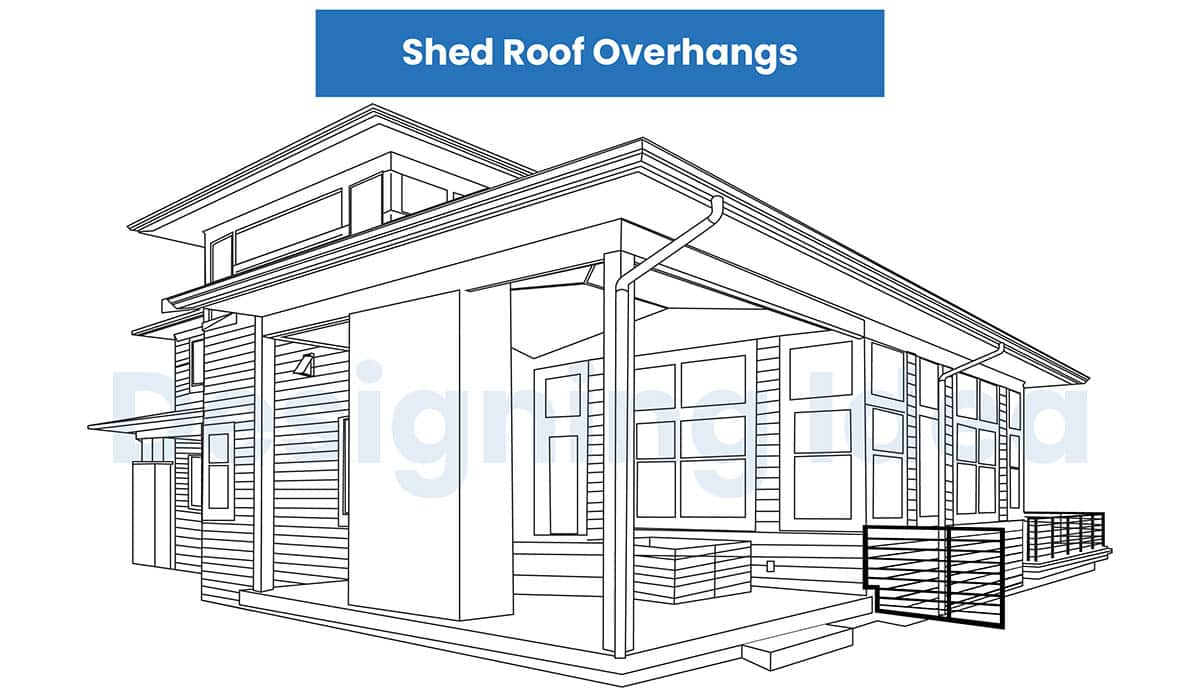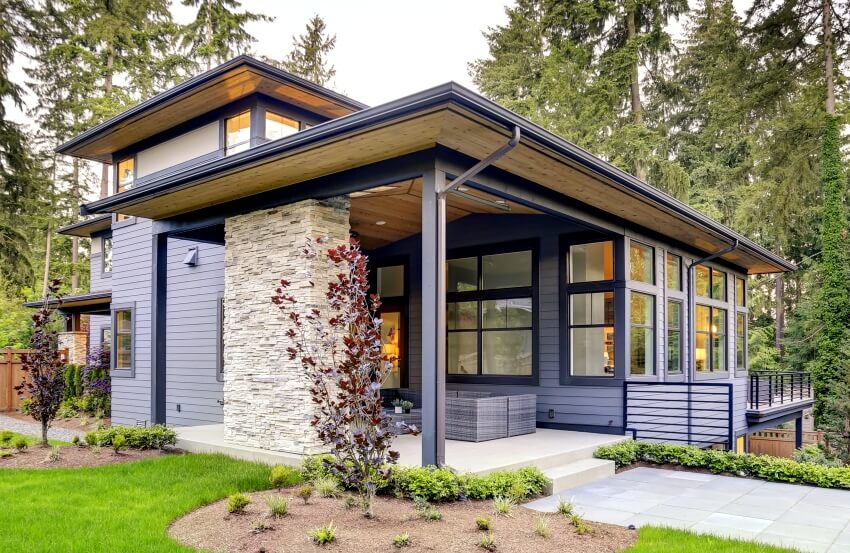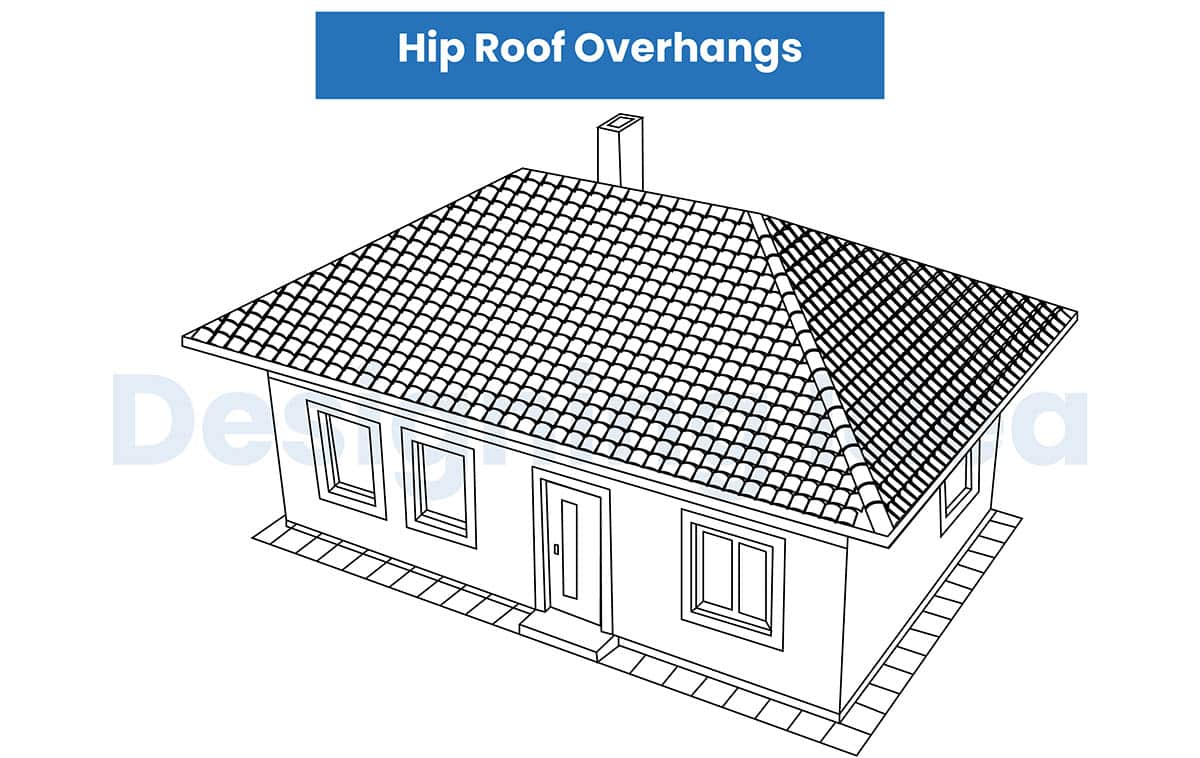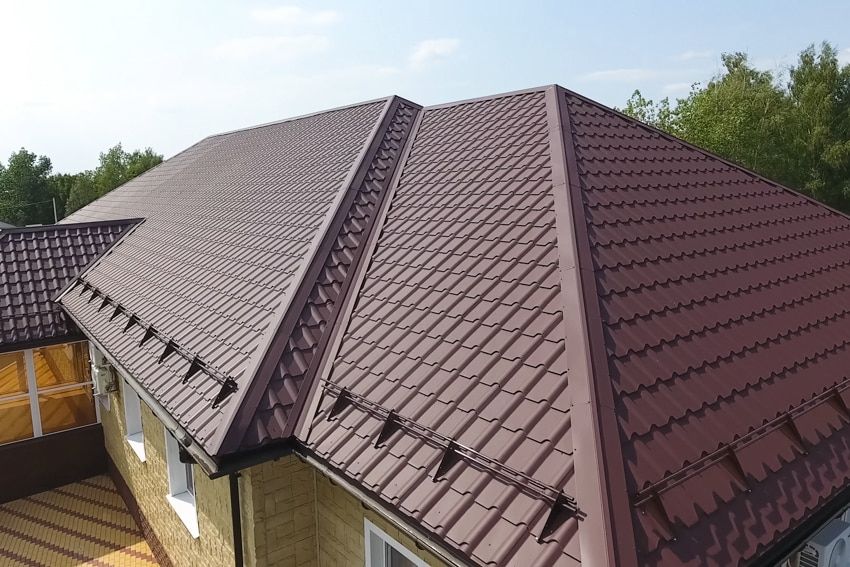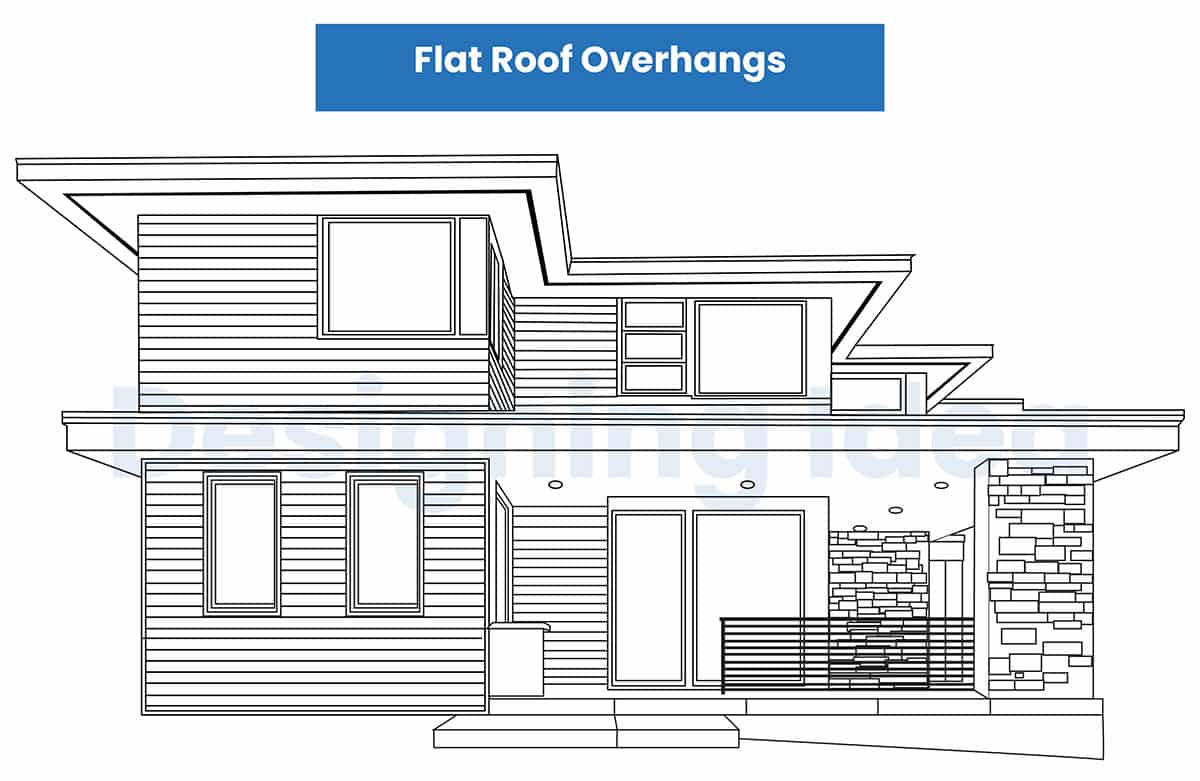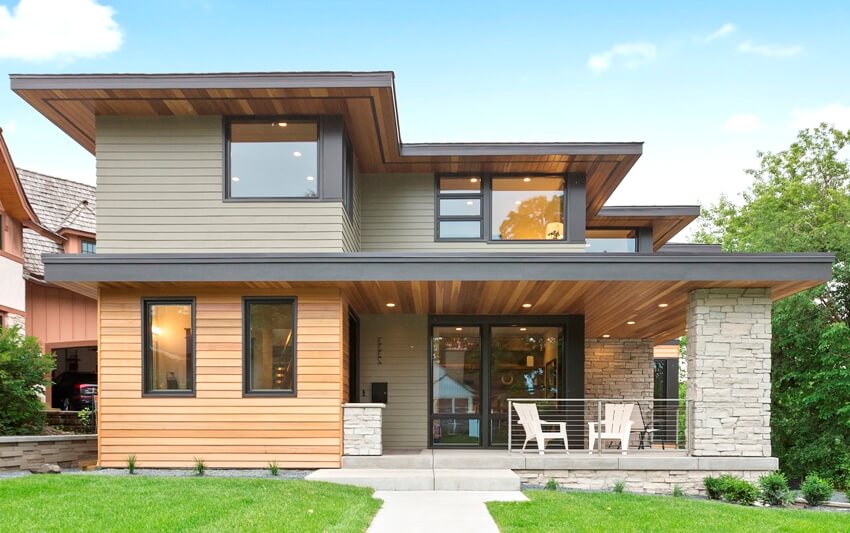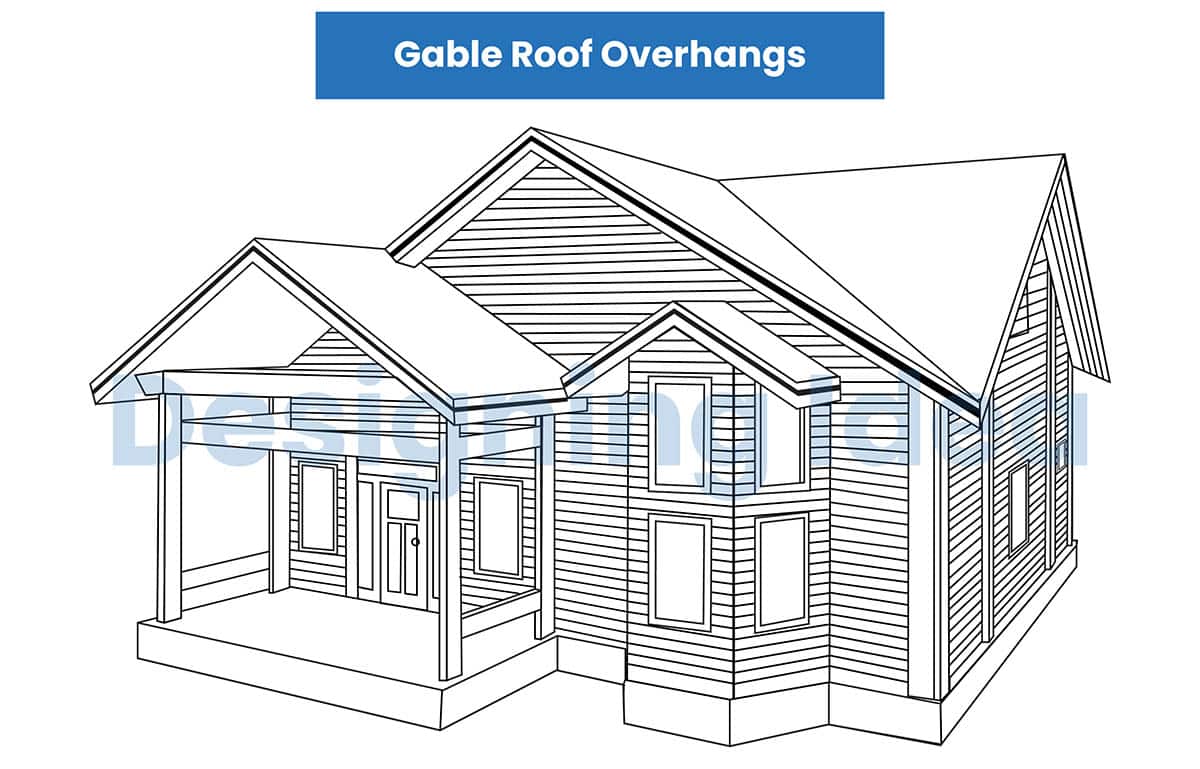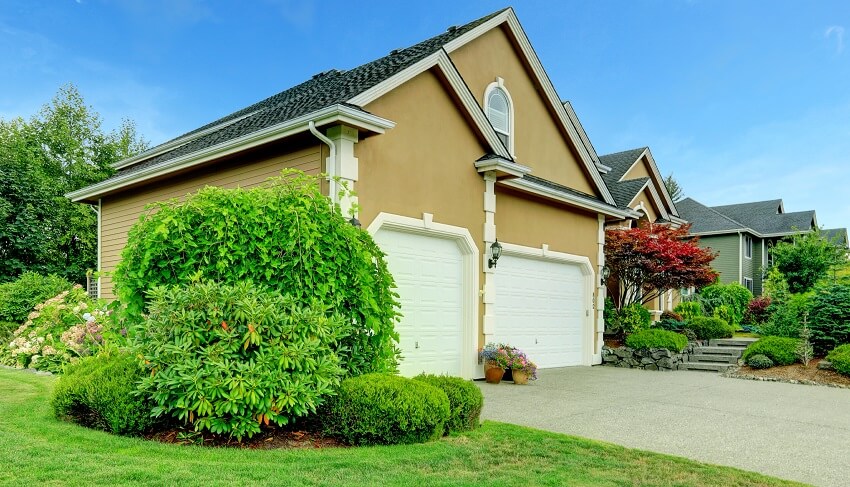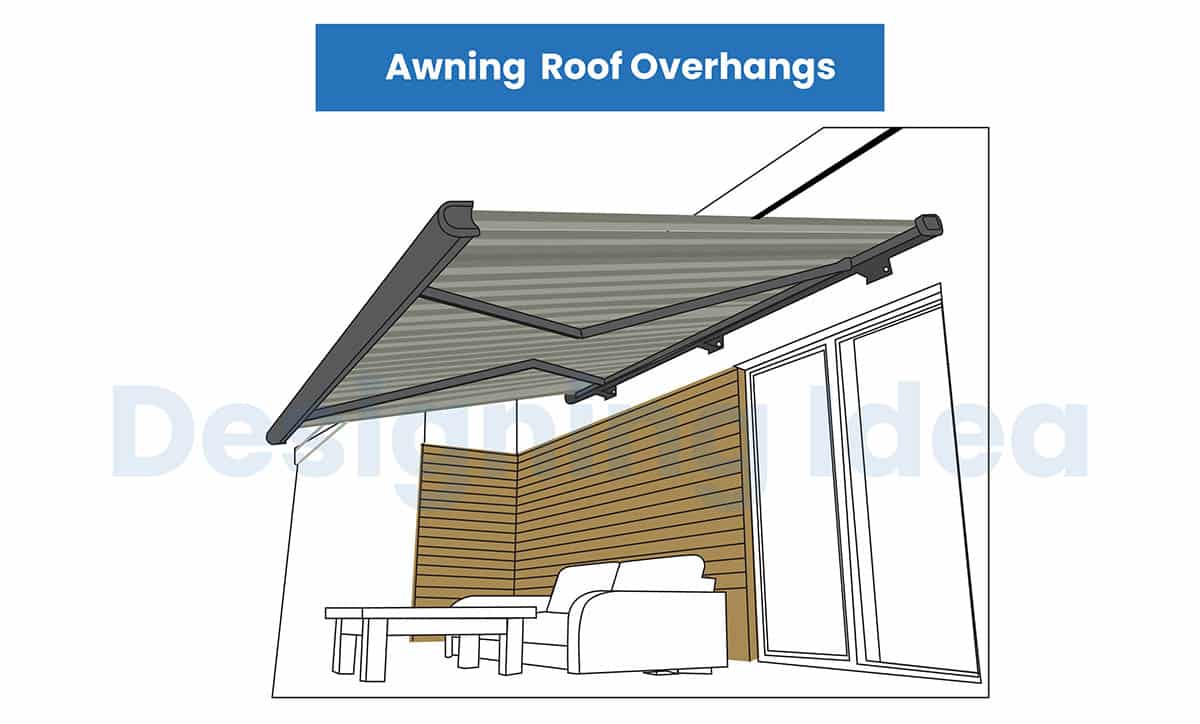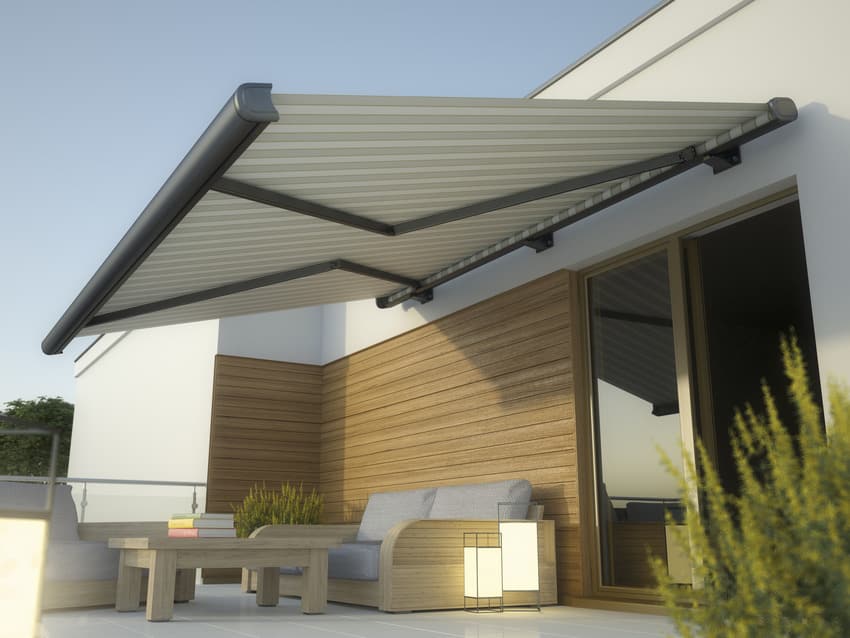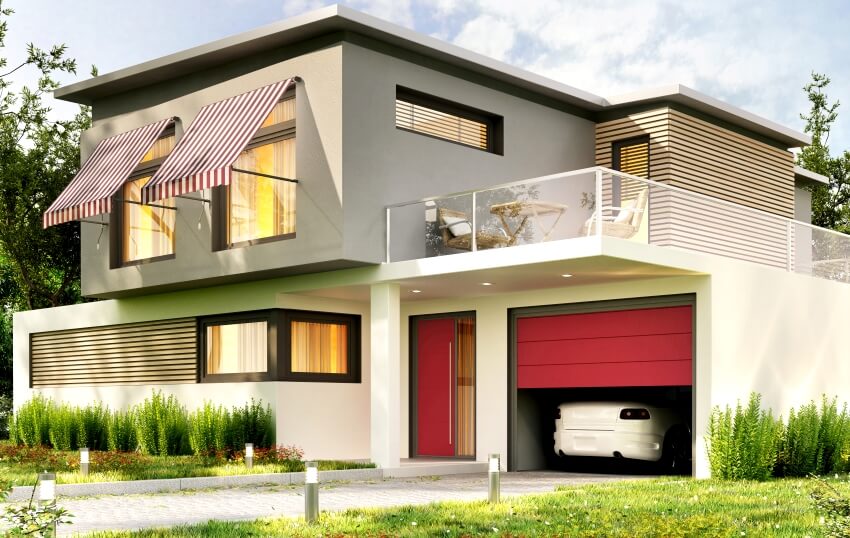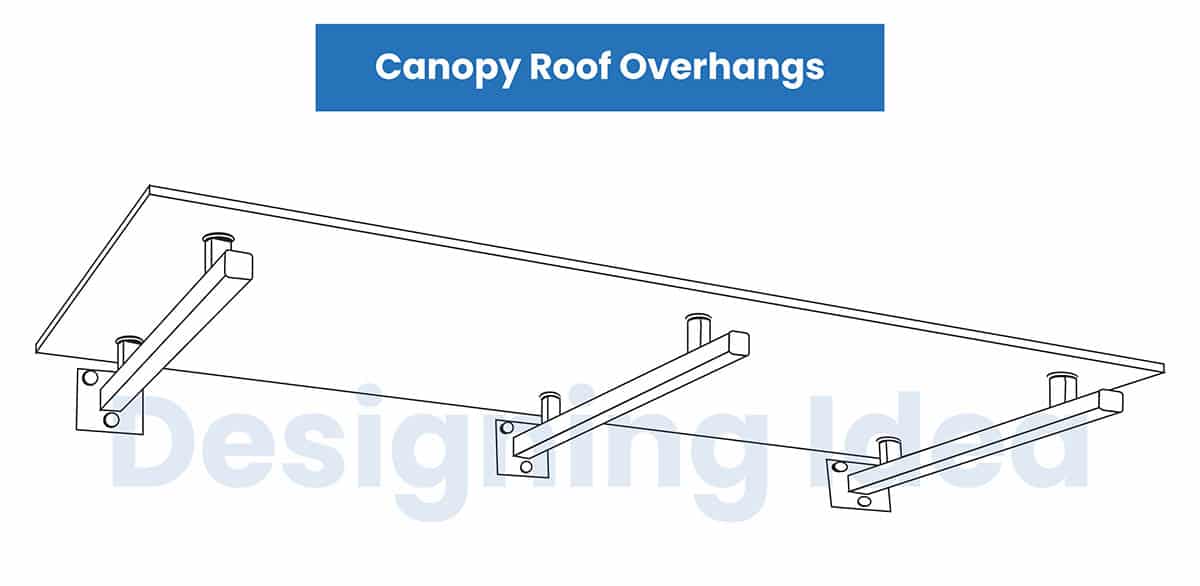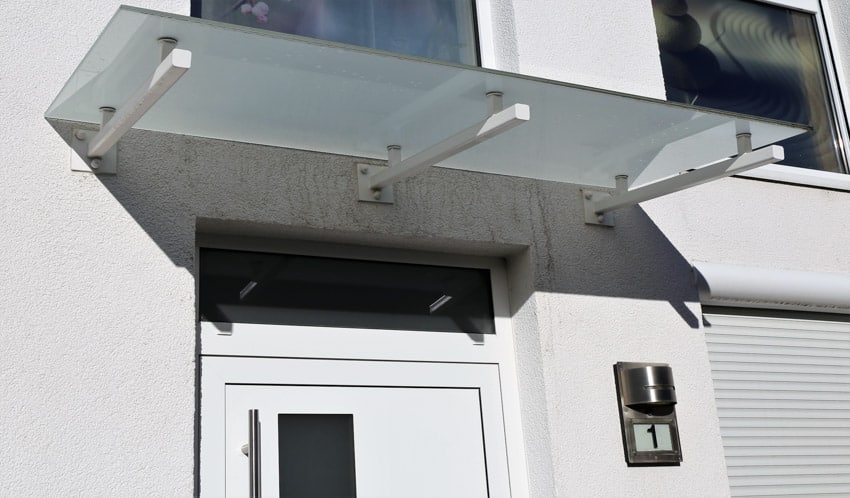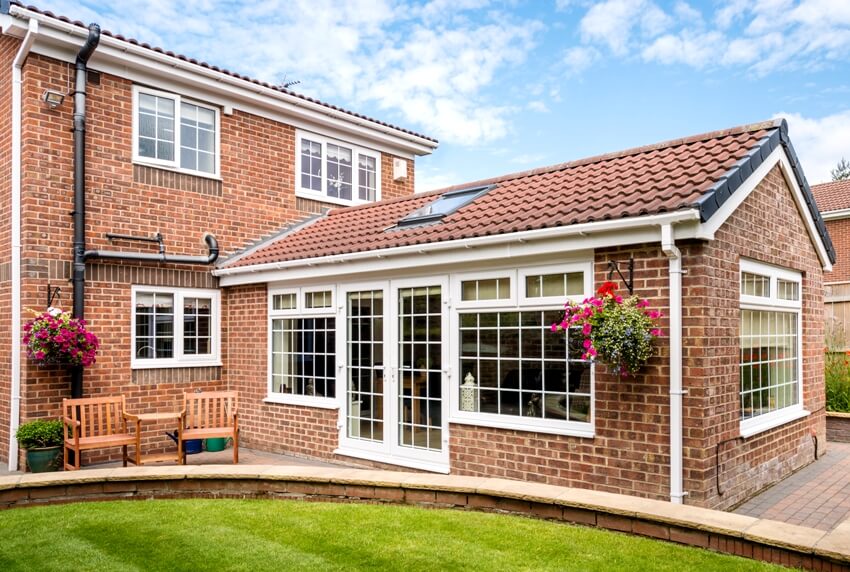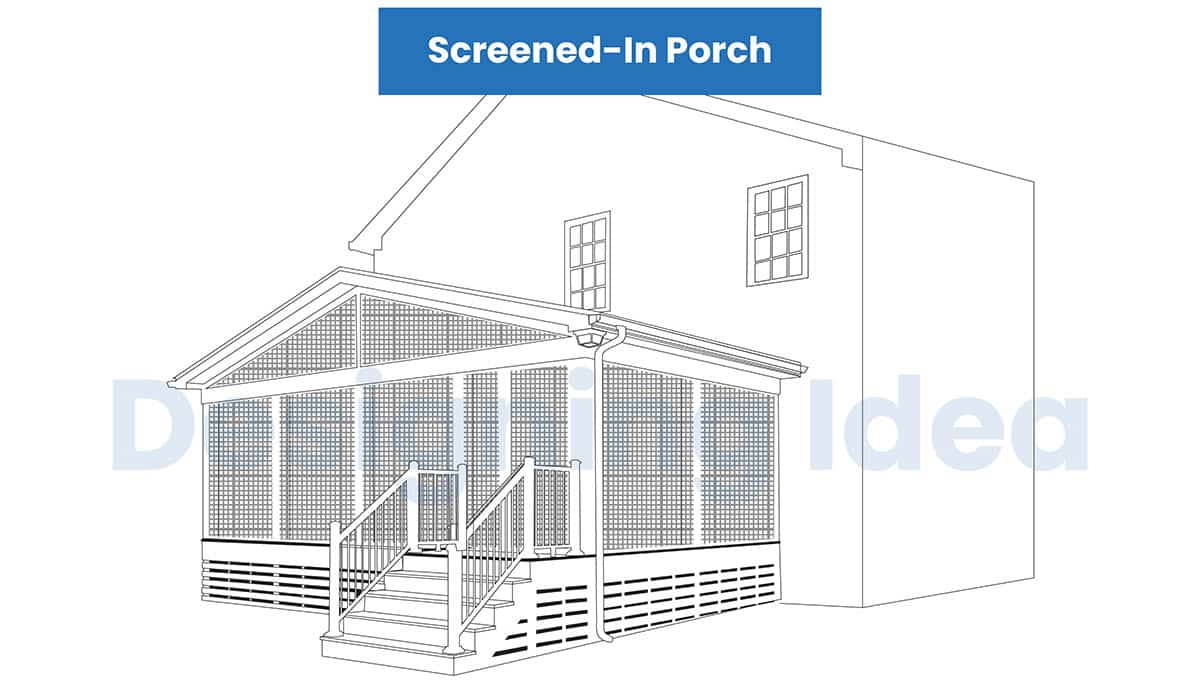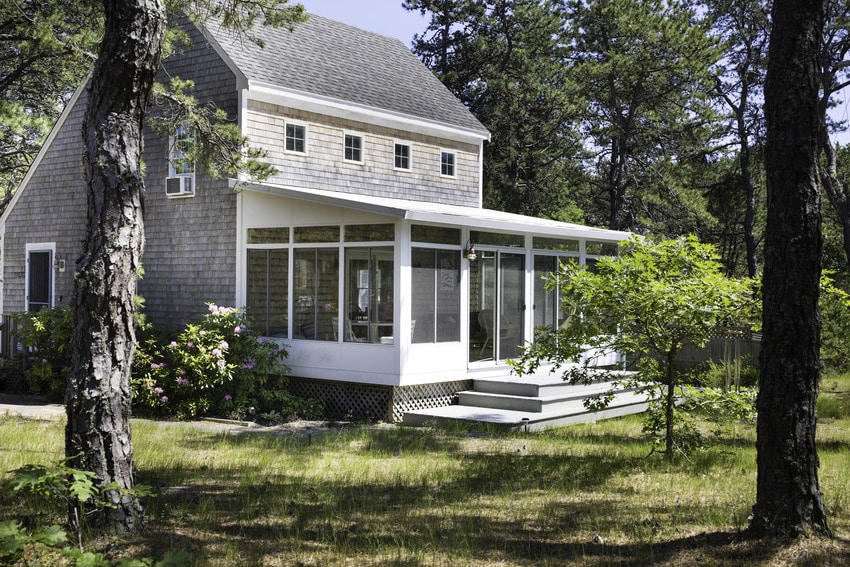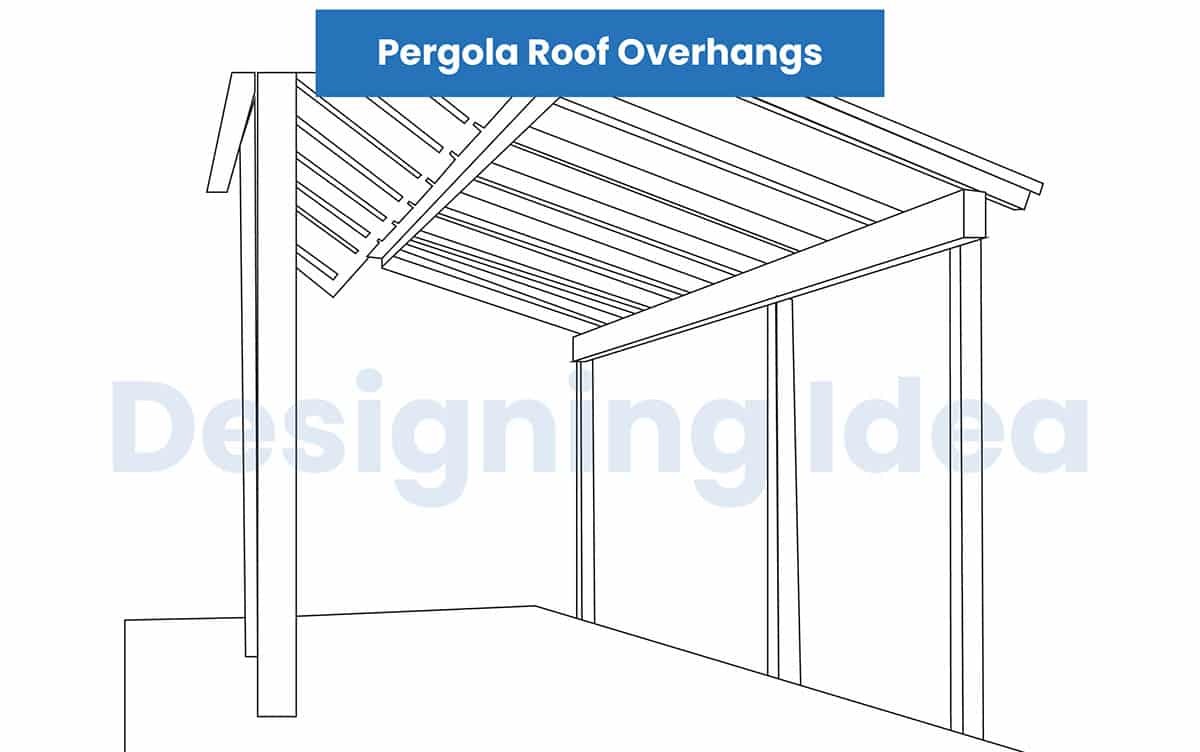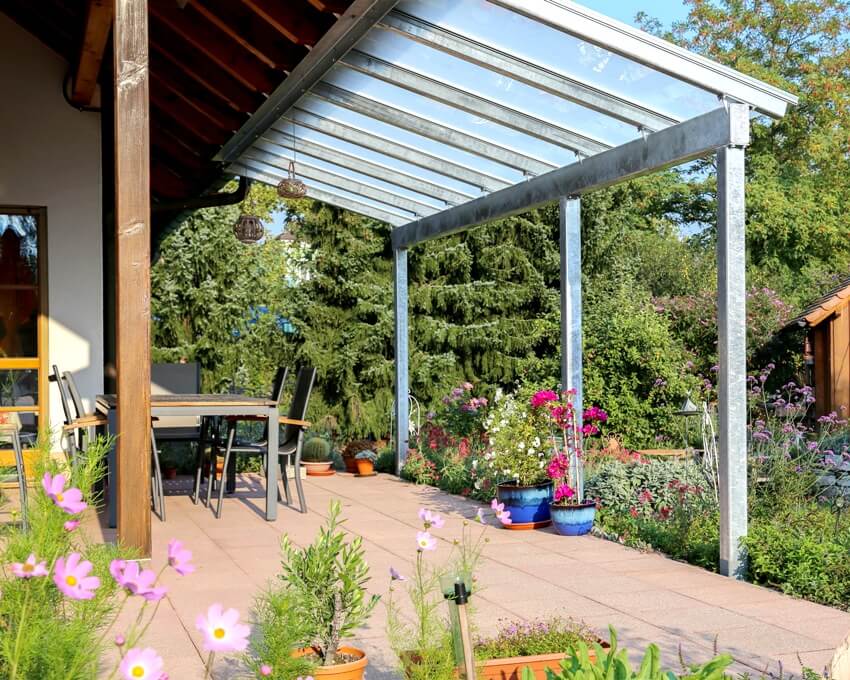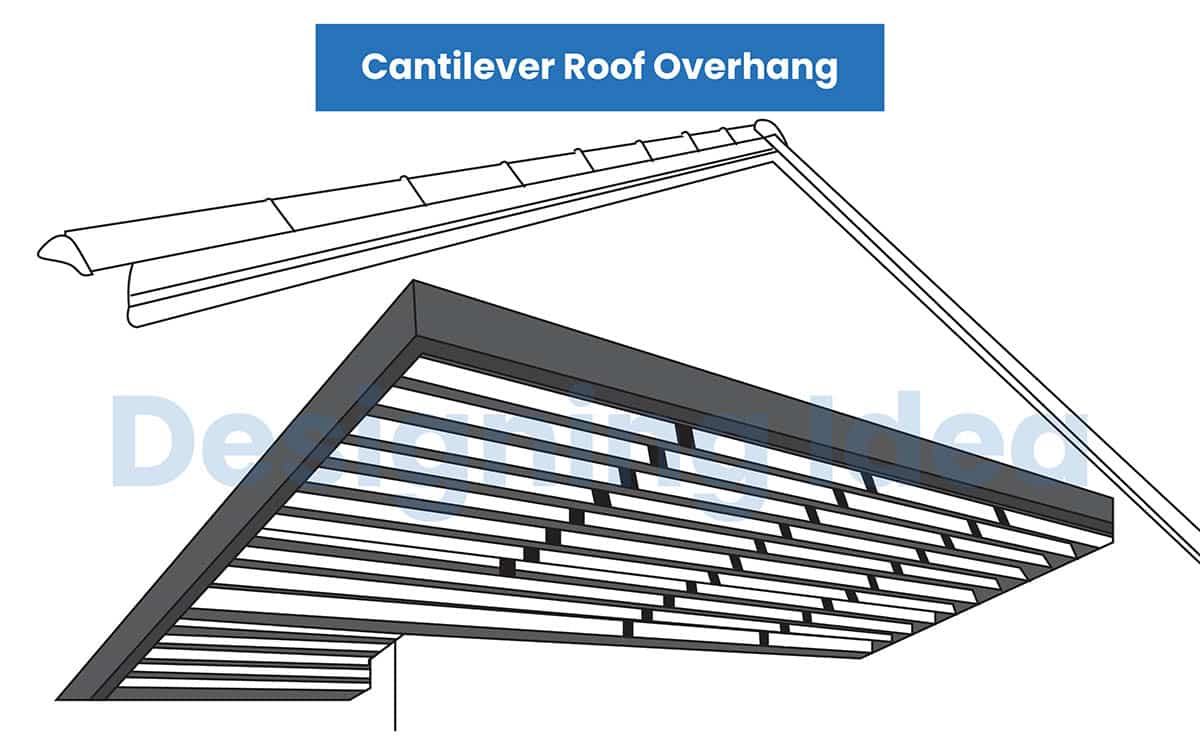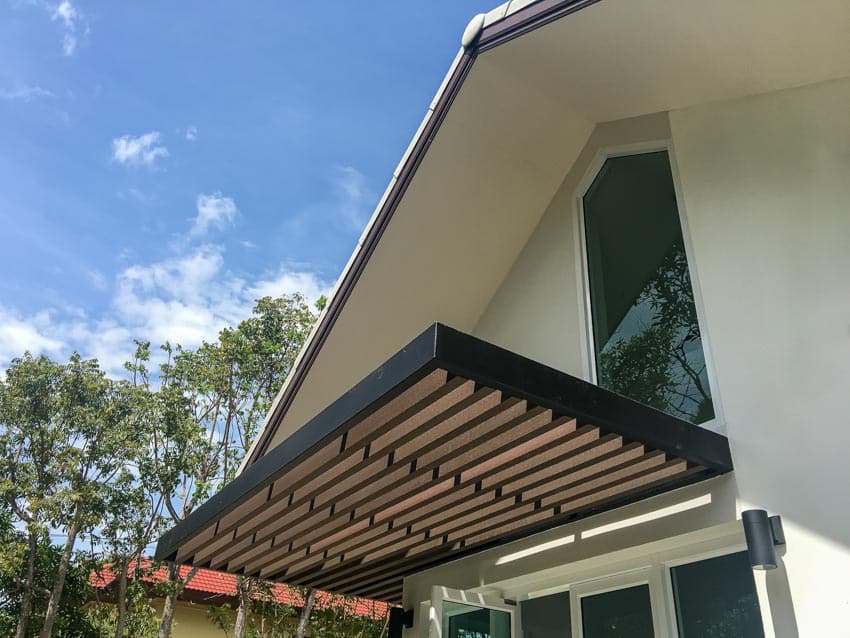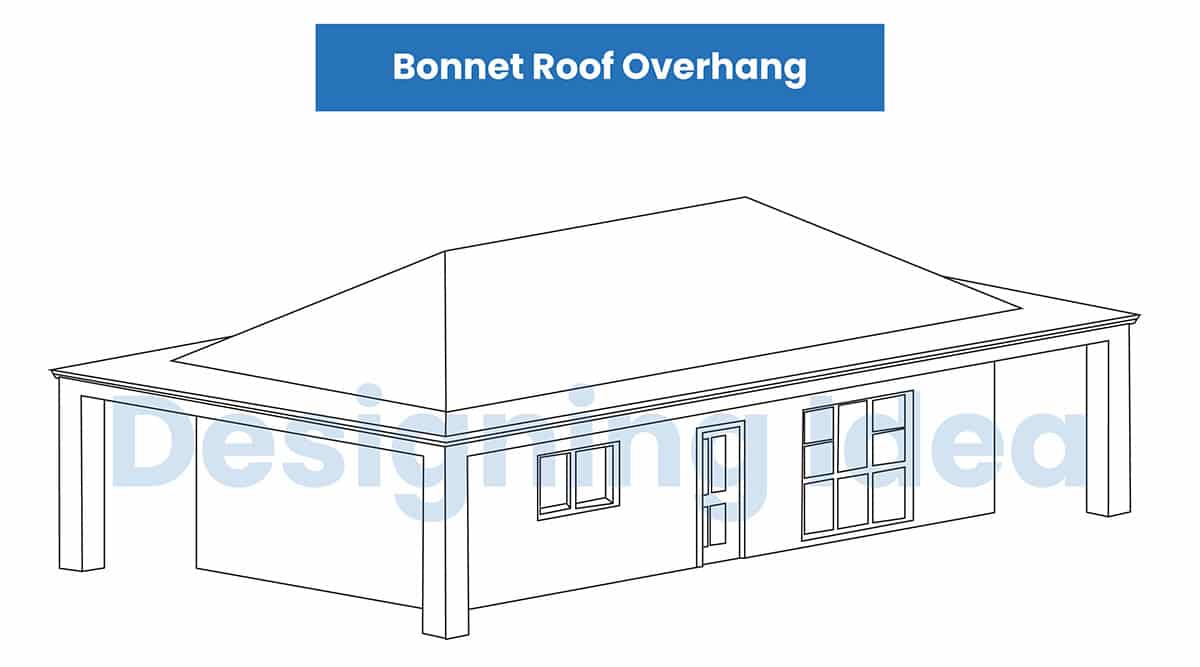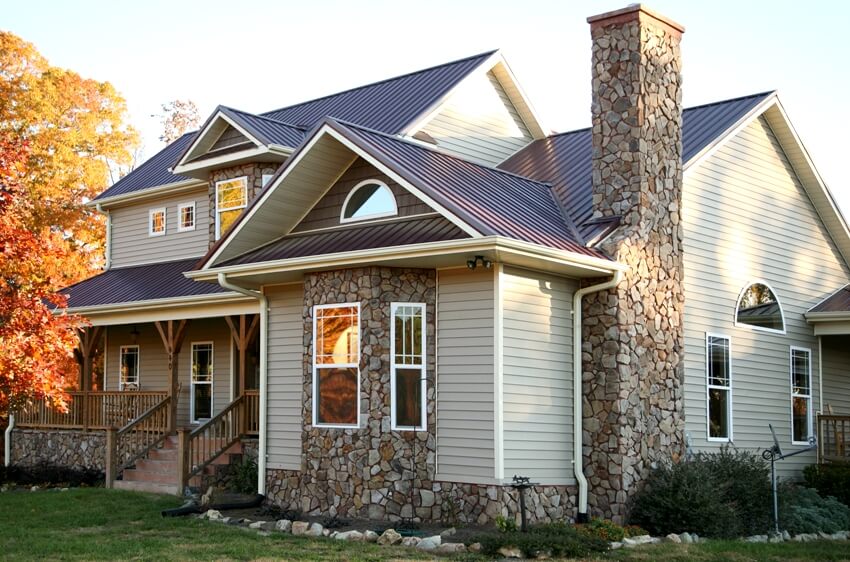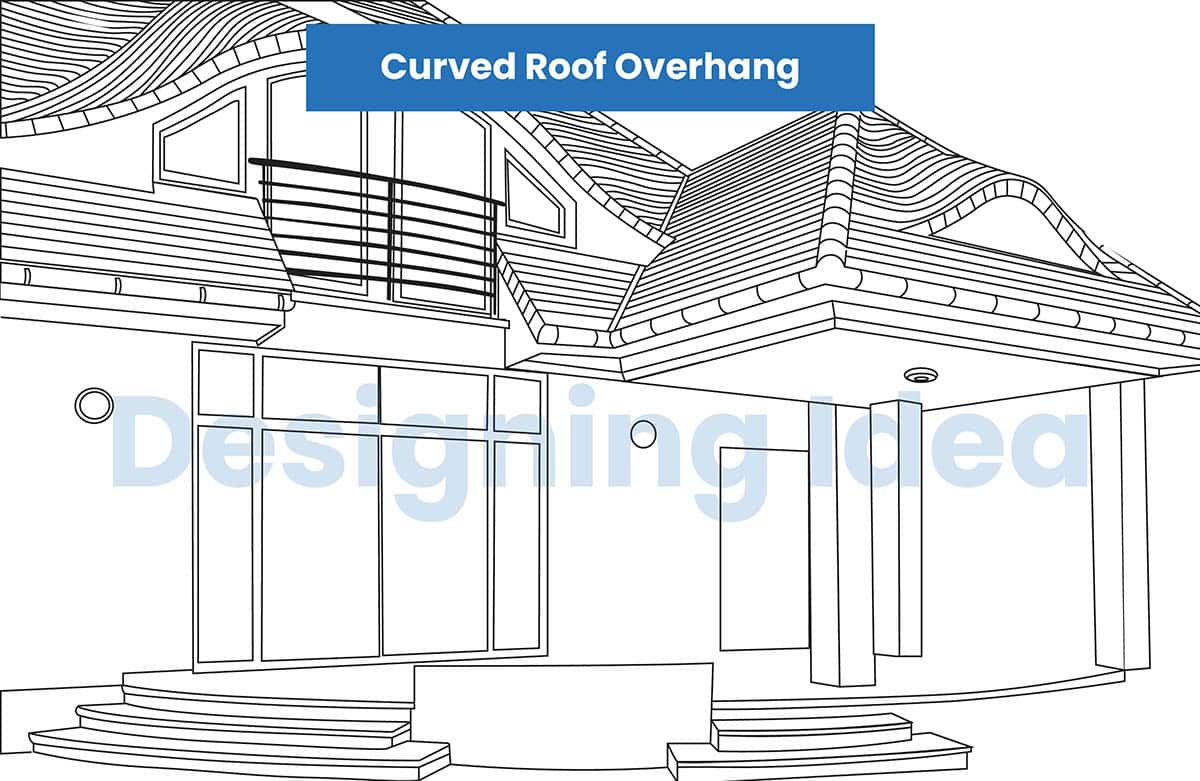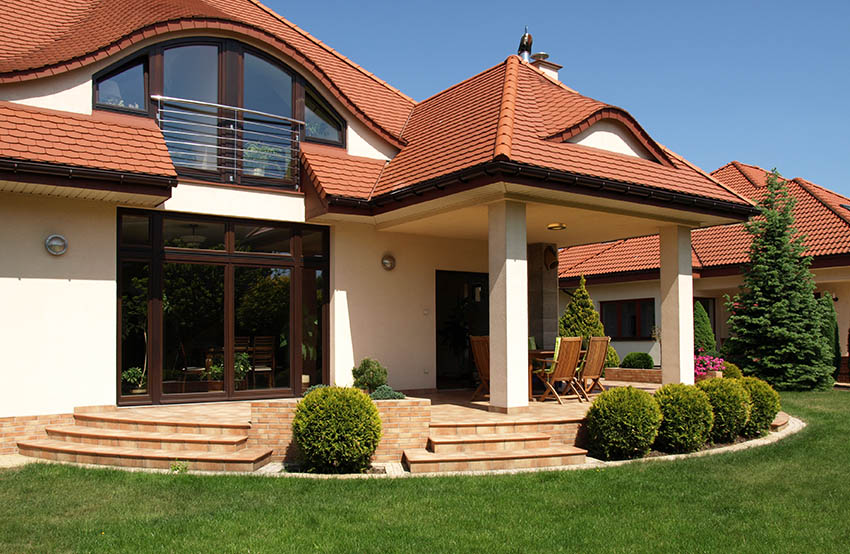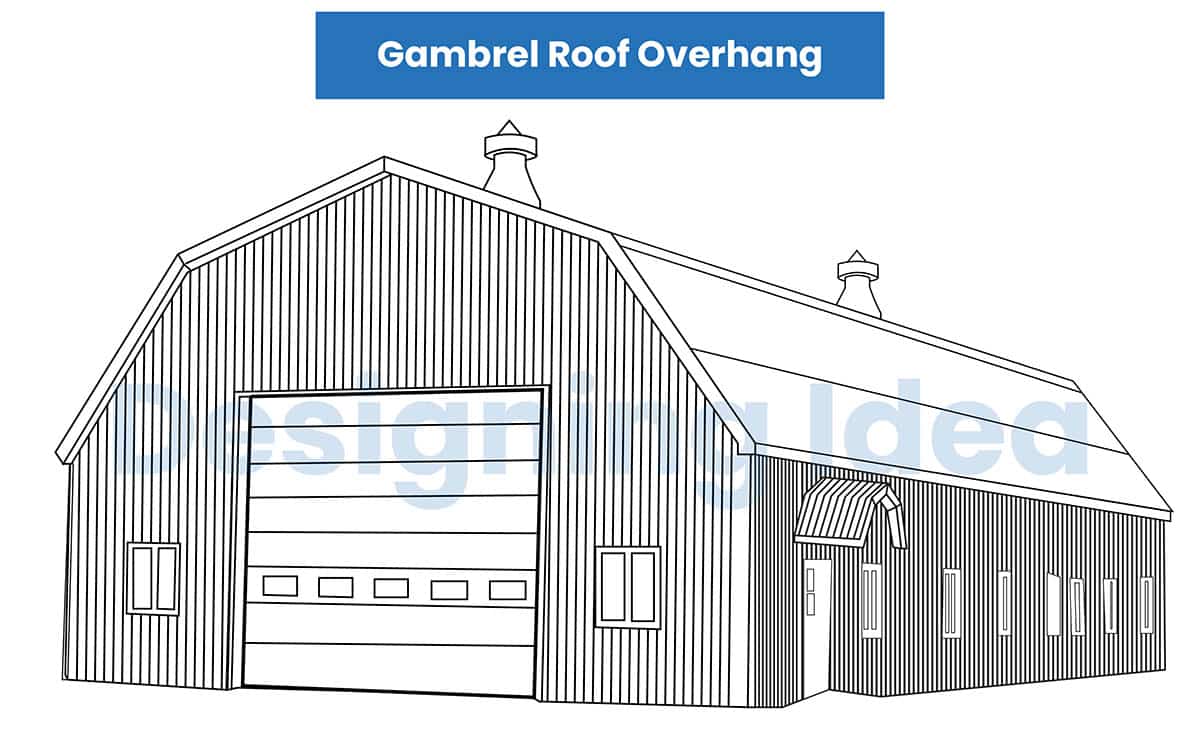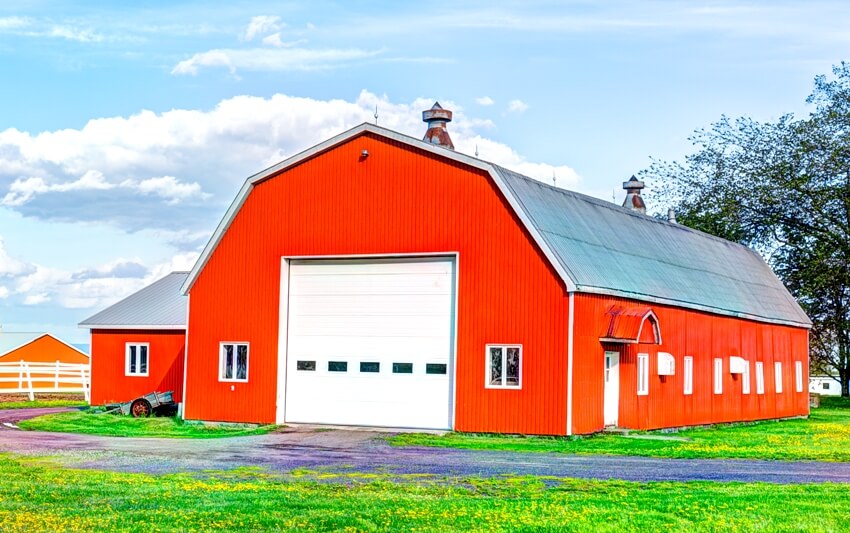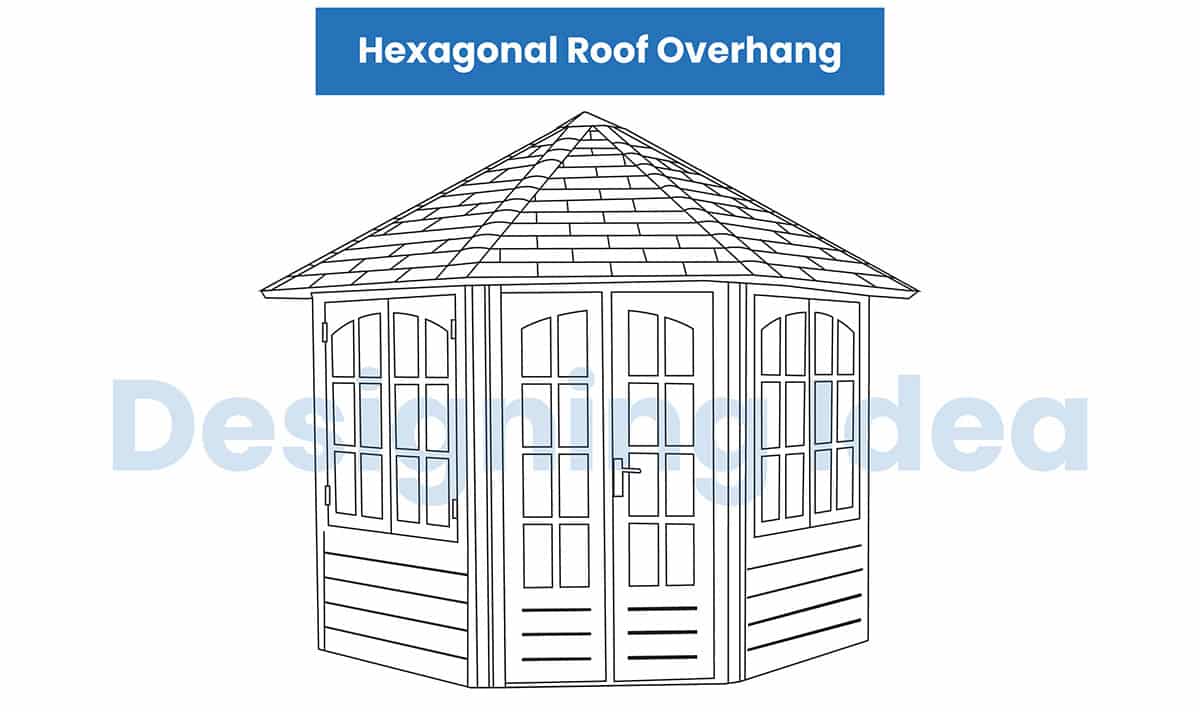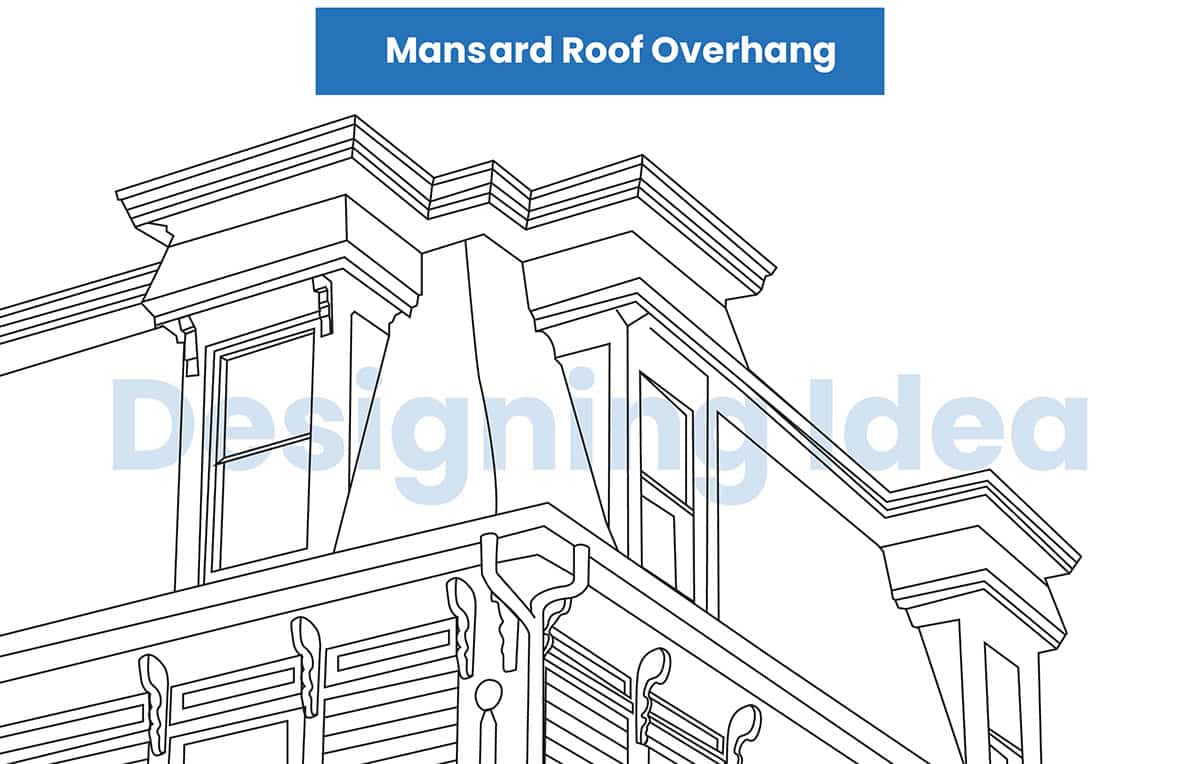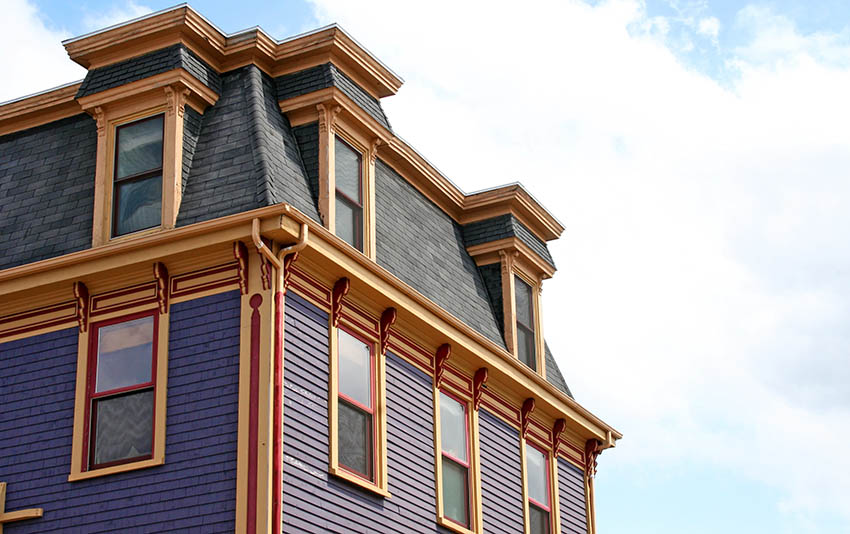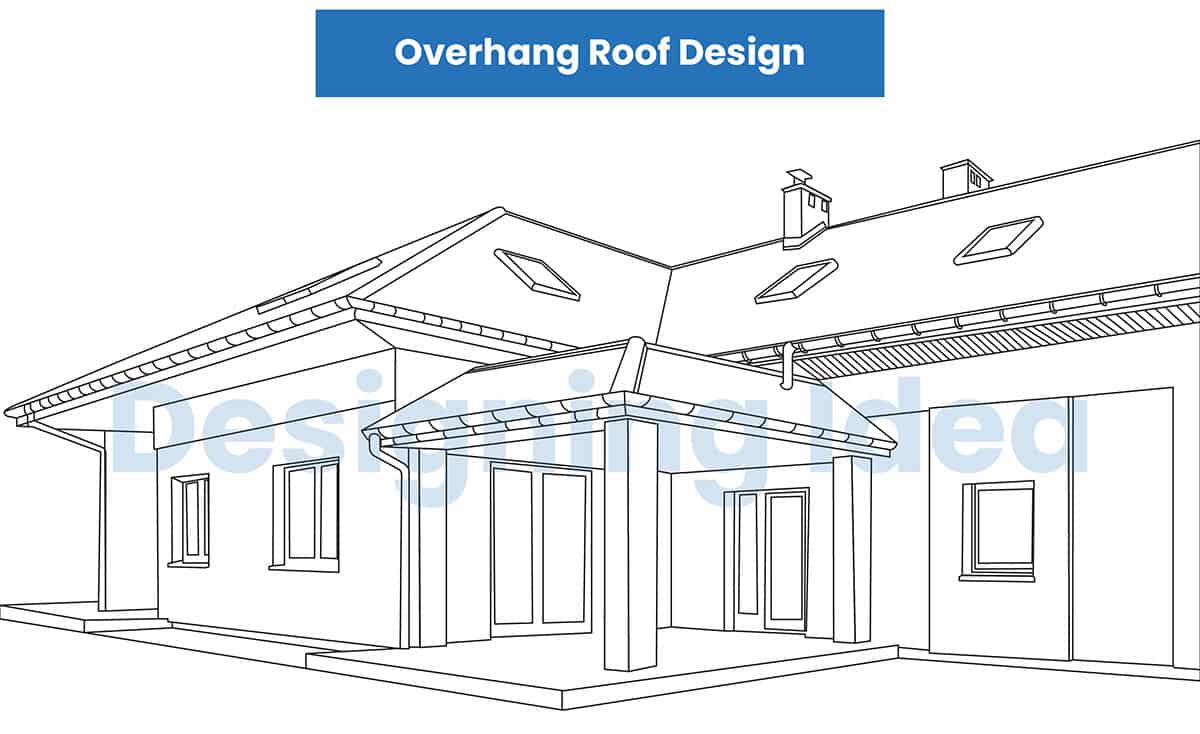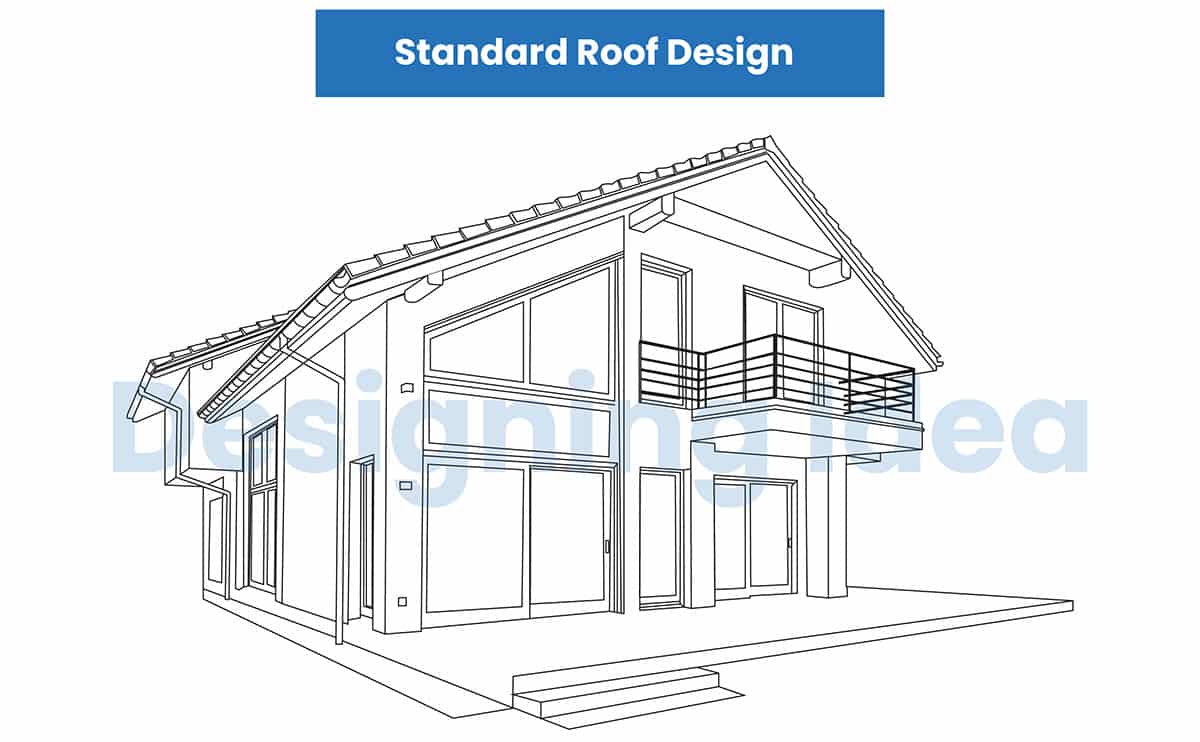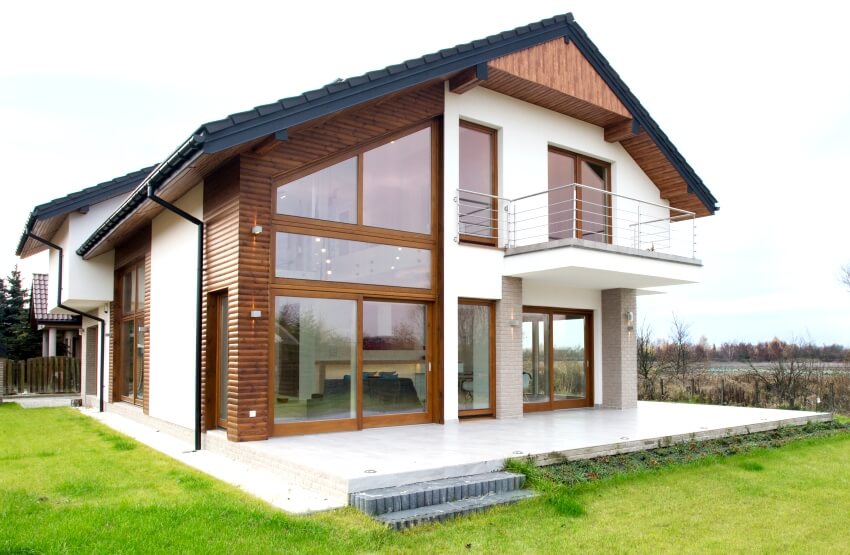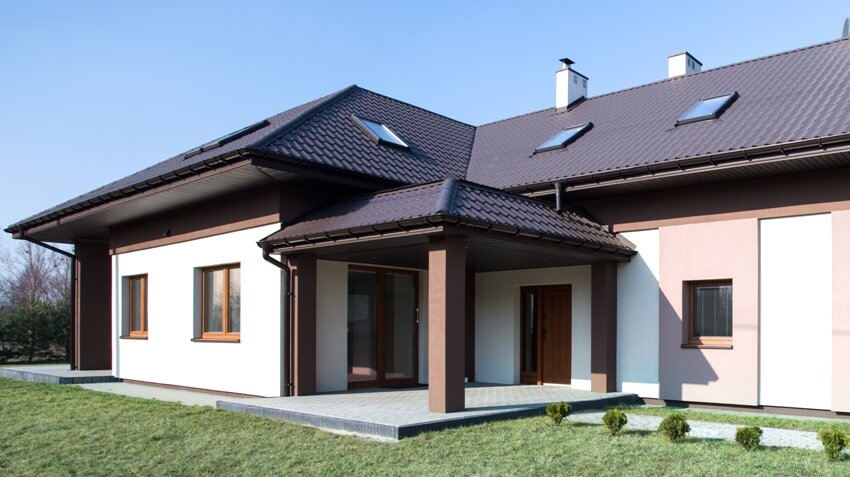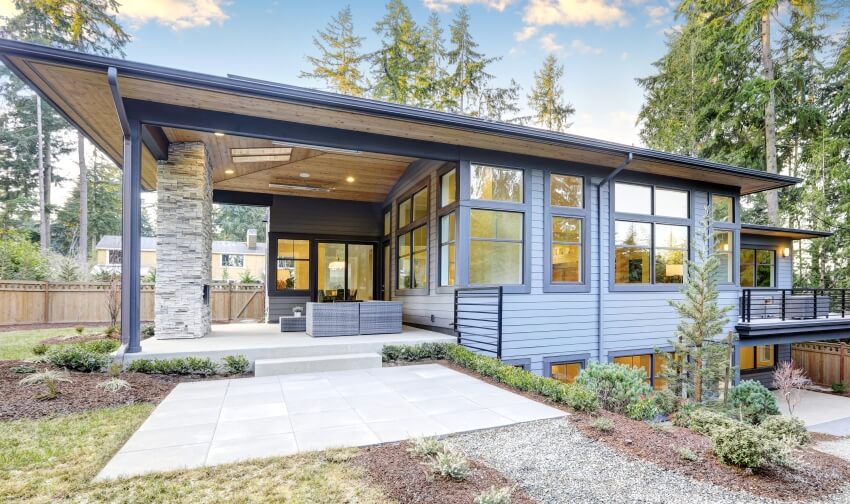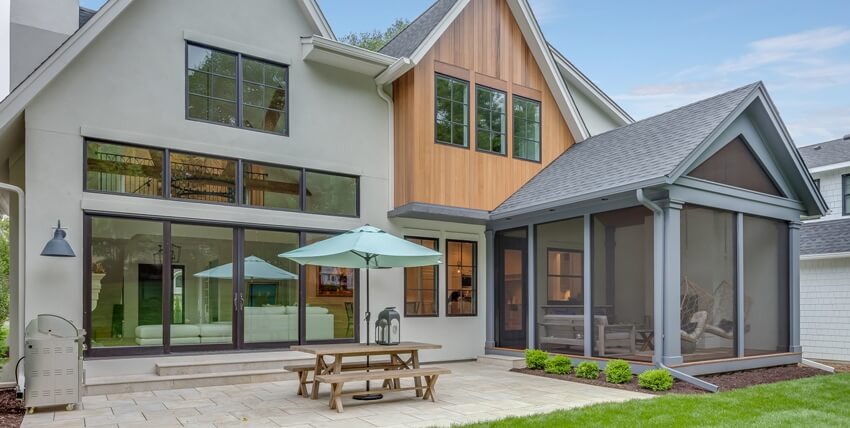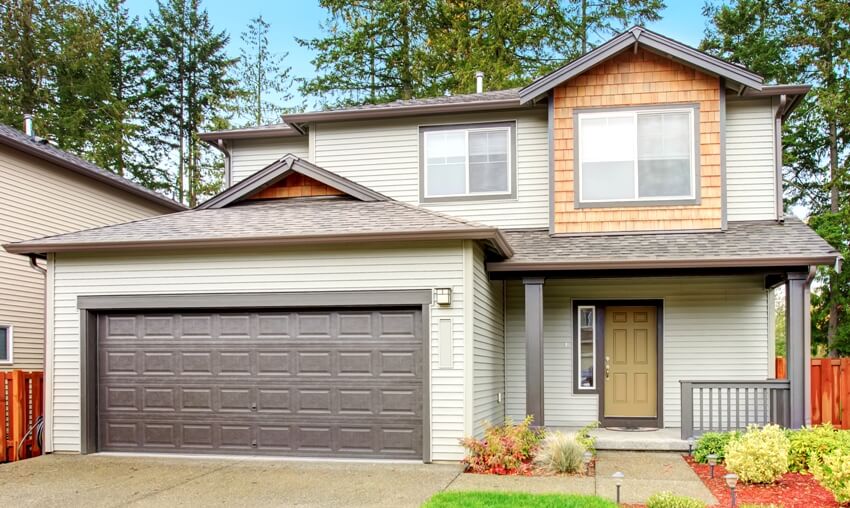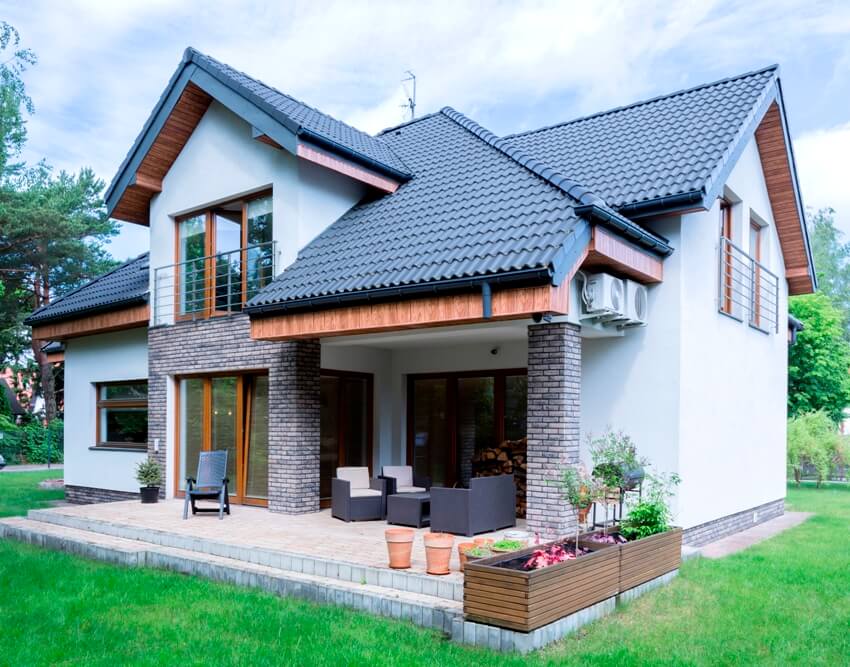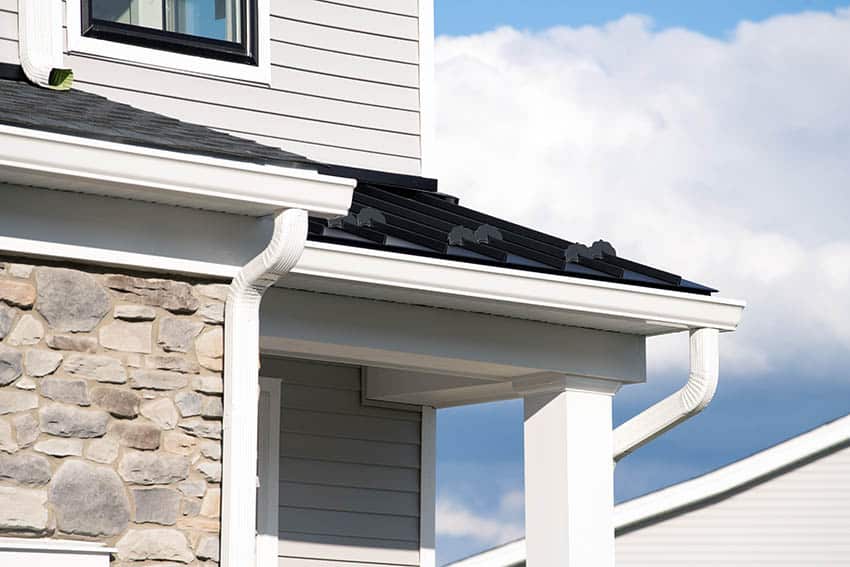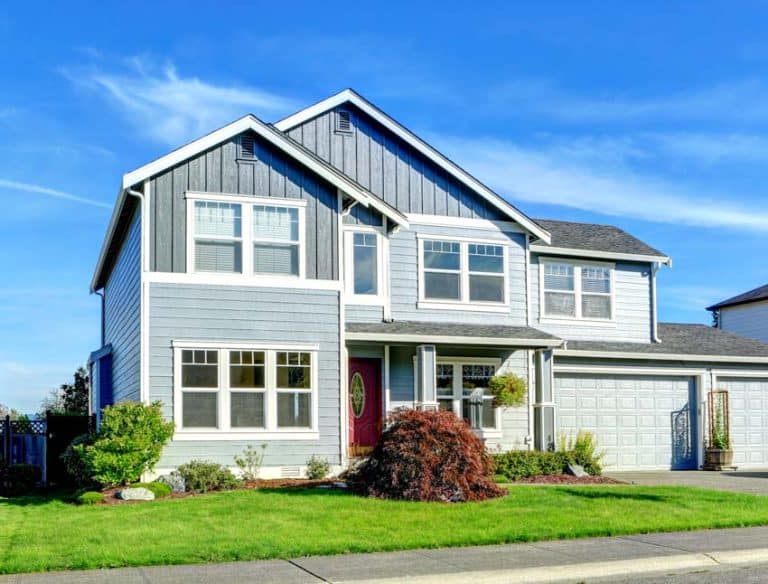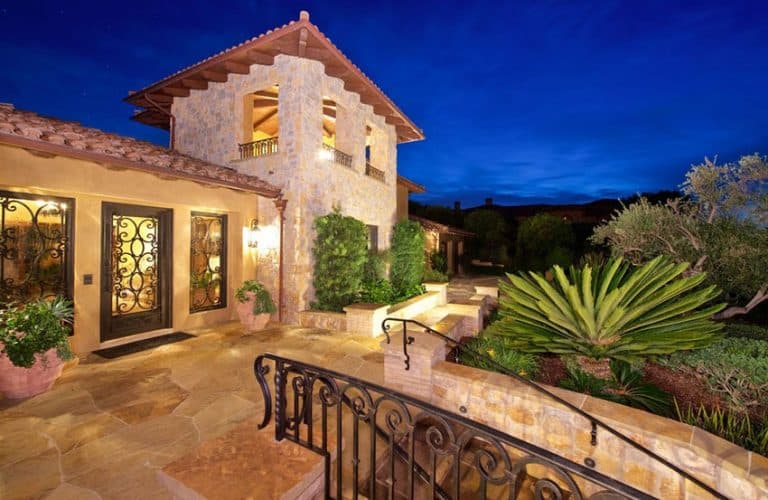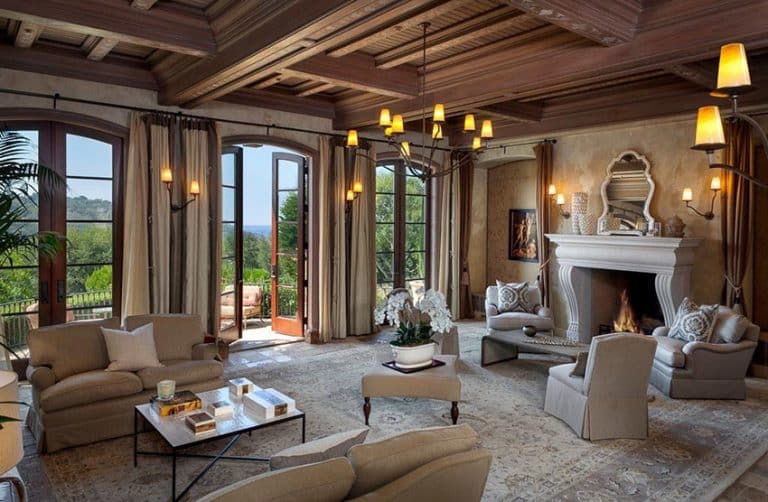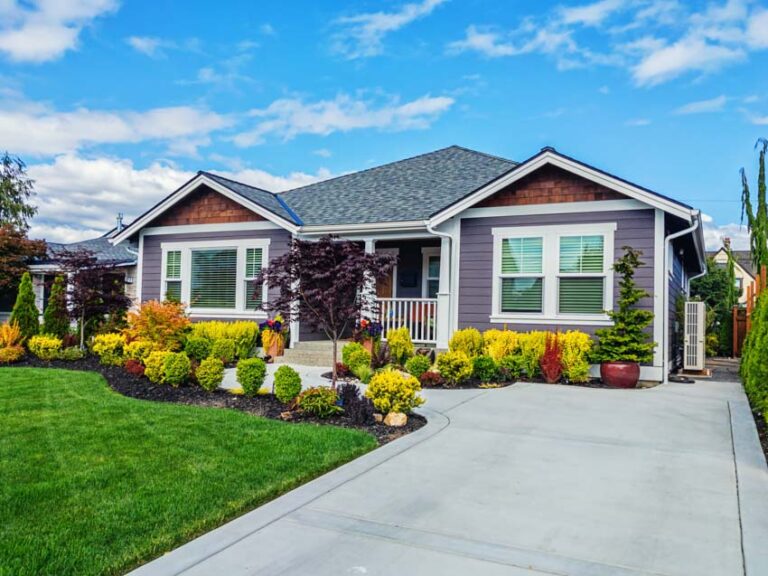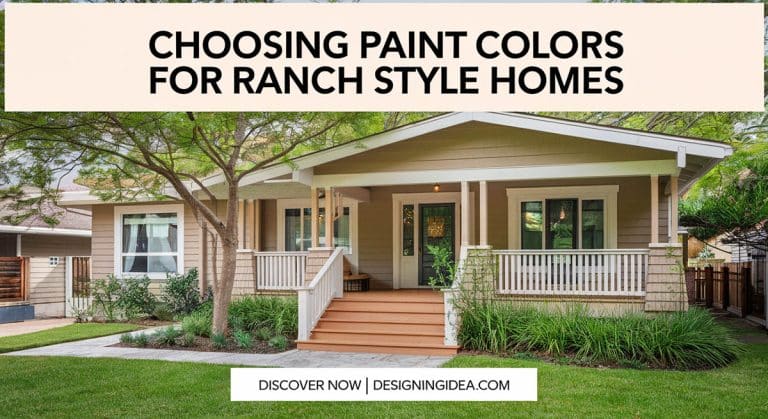19 Types of Roof Overhangs (Design Pictures)
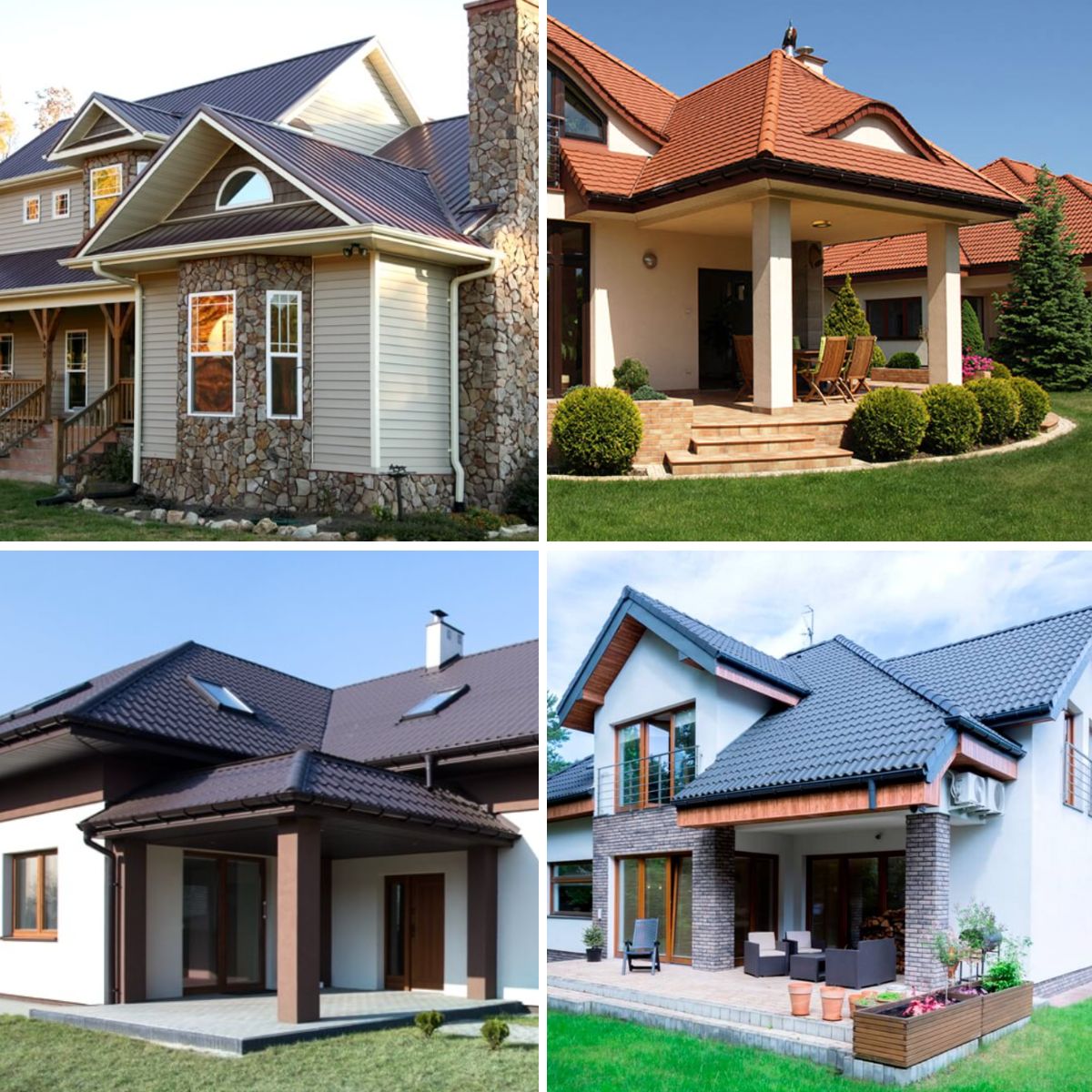
A roof overhang consists of how far the roof extends beyond the outside wall of a house or any type of building. An overhang is also called the eaves, and the underside is called a soffit.
The overhang protects the exterior of a house from strong winds, snow, ice, and rain from getting behind the siding. Continuous exposure to moisture can cause exterior materials to rust or rot.
Moreover, the added shade prevents glare and heat from the sun from reaching the windows. Solar shading is also an advantage in reducing energy costs and keeping the home cool.
The depth of an overhang is adjusted when the home is being built based on the climate. Houses constructed in rainy and tropical climates have more extended overhangs to protect from extra moisture.
These longer overhangs have a maximum length of 2 feet. If the rooftop overhang is extended, builders must install additional support to the soffit underneath. For drier climates, the overhang is shorter, and some homes may have no overhang at all.
A roof overhang is designed with the climate in mind or based on the type of building and architectural style of the home. This informative guide provides the types of roof overhangs and their sizes to help you decide which styles are the best for your home.
| Quicklook: Roof Overhang Styles | ||
| Shed | Canopy | Gambrel |
| Hip | Sunroom | Hexagonal |
| Flat | Screened-in Porch | Mansard |
| Gable | Pergola | Cupola |
| Awning | Cantilever Overhang | Oriel |
| Bonnet | Curved | |
Shed Roof
A shed or lean-to shed roof, is a popular type of roofing design with only one slope plane. Since it does not have ridges, valleys, or hips, it uses fewer materials, thus making a shed styles more economical.
Another name for shed styles is the skillion design, often used interchangeably for modern architecture. A skillion style is slightly more specific and usually refers to a single slope with a taller wall than a shed design.
Protection of the structures’ sidings and interiors against the elements. But like other roof types, a shed design needs an overhang to protect the building siding and the structure itself. A well-designed lean-to-shed roof is recommended to have a slope of not less than 15 degrees to allow rainwater to flow and snow to slide off easily.
Protection of the structures’ foundation. The overhang and the gutter system protect the structure’s foundation from continuous water and moisture exposure.
Aesthetically pleasing. Another benefit of a shed roof overhang is that it makes a building more aesthetically pleasing. A shed roof has become a preferred type for many contemporary-themed homes and commercial establishments due to its modern appearance.
A structure with a shed roof without an overhang is possible using inner or hidden gutters or a permeable structural skin, but it can be more expensive and add to the construction time.
Longer overhead cover. Since modern materials have allowed longer spans with less structural support, such as metal frames and foundations, a deeper overhang that goes beyond the maximum 24 inches is now possible. A longer overhead cover provides additional space for patios and receiving areas or serves as an optional parking space.
Hip Roof
A traditional type, the hip roof has four sides and four eaves that slant down on all sides and angles, which makes it more difficult to construct compared to a gable roof.
Hip roofs are typical in colonial, craftsman, ranch, Mediterranean, and French-style homes. Types of hip roofs include pyramid, mansard, hip and valley roofs, and combinations.
Best for homes with high winds. The coverage and profile of hip designs provide a better aerodynamic structure that is combined with a good overhang depth. This system distributes wind force across the structure and reduces damage during strong winds.
Efficient shading and energy savings. Since hip roofs cover all sides of a building, it’s an opportunity to have an ample overhang depth that adds protection over doors and windows against the elements.
When following a passive solar design, typically, the south side of a structure should have a longer overhang as windows can be exposed to unwanted sunlight.
Overhangs can be an attractive feature. A structure with a hip roof without an overhang is unusual and can look visually unappealing, not to mention the damage it receives from constant exposure to the elements.
Hipped-roof homes, especially bungalows or residential one-story homes with overhangs, can look elegant with the continuous slope against a natural setting.
Flat Roof
Originating in arid countries, mainly in the Middle East and Egypt, flat roofs are named as such due to their almost level slope (less than 10 degrees) to allow water to drain on one side.
Flat roofs in homes have been heavily incorporated during the popularity of the Prairie style, chiefly by Frank Lloyd Wright’s cantilever roof overhangs, which were quite advanced during the 1900s.
Today, flat roofs remain a preferred roofing design for many modern and contemporary residential, commercial, and other types of building occupancies due to their clean and simple form.
Prevents unsightly water damage. Flat roofs can either have an overhang or not, but these structures typically come without overhangs and rely on internal drainage systems and waterproofing.
A parapet wall with scupper drainage is common for flat or hidden roofs, but water leakages are common at or near the drain area. Providing some extended ledge away from the sidings means lessening water damage to the sidings and the structure itself, a common challenge for flat roofs.
Aesthetically more pleasing for two-story structures. Aside from protecting the structure from water damage, flat roofs with overhangs usually look better with an overhang, especially at the gutter edge.
The extended overhang with cleanly closed eaves, such as cascading cantilevered projections from the entryway, and the flat design look modern and practical for these structures.
Protects clerestory windows. A favorite feature of flat roofs is clerestory windows, especially in modern and minimalist styles. A longer overhang will help prevent glare and unwanted heat while still providing natural light through the upper areas.
A flat roof overhang over an entrance needs to have an angle from the wall of the house to the overhang to help with water runoff.
Any other flat roof overhangs on the home also need water runoff provision to prevent water pooling and possible leaks. Read more about flat roof pros and cons here.
Gable Roof
One of the most recognizable types of roof design, the gable style is basically having a hip style without the front and back sides. The result is a triangular-shaped slope on each side that meets at the top, forming a ridge.
The lower edges will result in each side having an overhang of the building. Compared to a hip roof, gable roofs are commonly more affordable in materials and labor than hip designs for materials and labor.
Ensure continuous flow of air ventilation. Gable overhangs with boxed-off designs are an opportunity to install soffit vents, these are small punctured holes that continuously line up the underside of the roof overhang.
Together with an attic vent at the ridge, the eave or soffit vents provide a continuous flow of air ventilation.
Prevents glare and overheating during the summer. Gable roofs with high-pitched elevations provide ample headroom for loft areas for single-story structures or attic space for two-floor buildings.
An attic space can maintain a comfortable temperature for an attic space since the overhangs provide shade that covers the upper windows.
Awning Roof
While not technically considered a type of overhang, an awning provides some of the benefits of a roof overhang. An awning is usually detachable from the structure and made from a form of textile that was first historically used in ancient civilizations such as Egypt and Syria for entryways and market stalls.
Like their ancient use, awnings today cover entryways and act as a temporary shade for patios and other outdoor spaces. Stationary awnings are also available and are attached to the siding of the building.
There are modern awnings that can be adjustable and retractable to be automatically closed or opened when needed.
Window shade. Awnings are commonly seen in restaurants and cafes with large windows where the awnings can be opened to provide shade during the day.
Second-floor windows can be left open while still allowing cross ventilation through the rooms with awnings installed above opened windows.
Entrance Door Cover. A door awning can be an attractive feature as well as functional. It provides the needed protection for the entry door structure, prolonging the service life of the hardware and the door itself.
Additionally, it provides cover under the elements for people who exit and enter the building, providing more time to close or open an umbrella or when waiting for the door to be opened when entering.
Add Character to the Structure. A striped or checkered awning with scalloped edging is an identifiable design for restaurants and cafes, making it an attractive feature for commercial establishments.

Retractable Awning
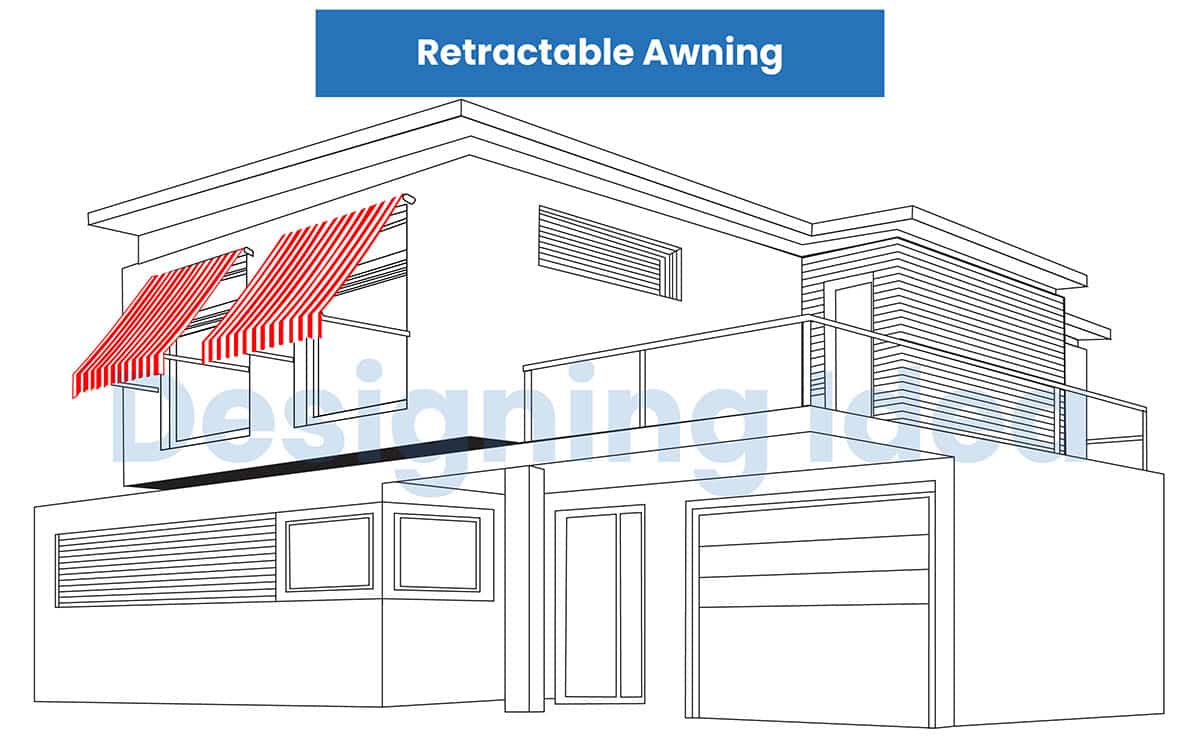
The awning can be extended completely for the most coverage or partially according to how much coverage is desired. Retractable awnings also protect from inclement weather.
Juliet Awning
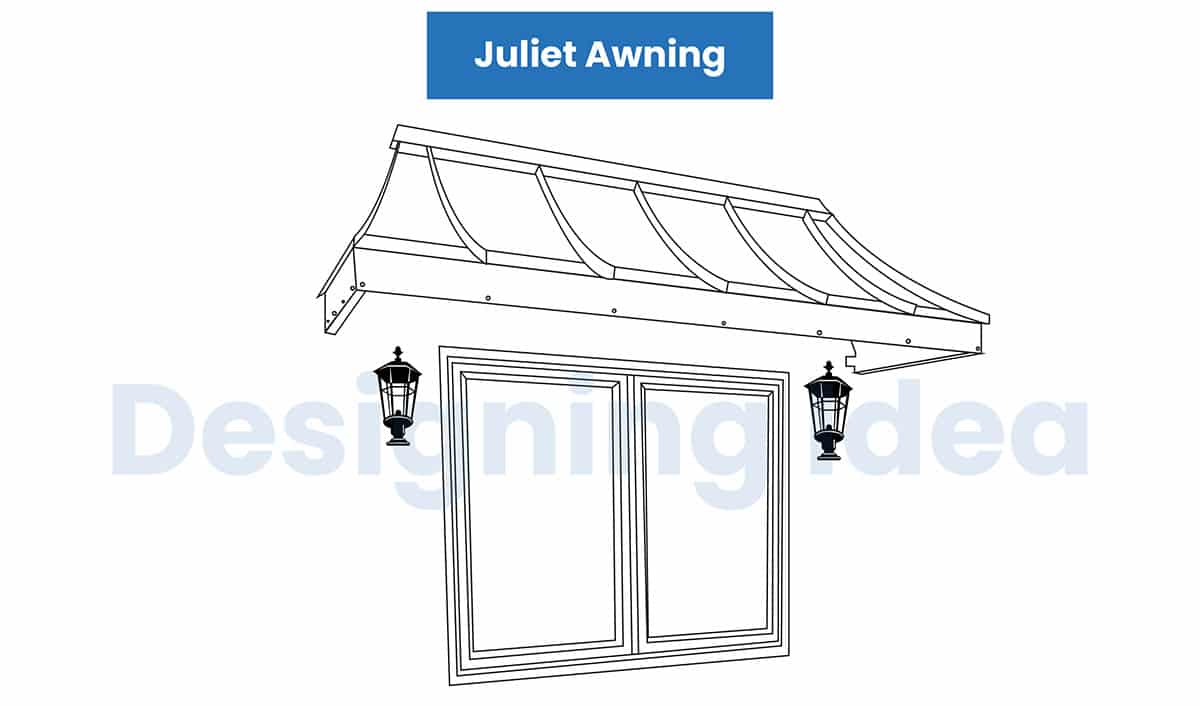
Juliet awnings come in metal, copper, aluminum, and steel and offer a distinguished finish to entryways and windows protecting from weather and sun.
Canopy Overhang
A canopy overhang is used for entry doors when space is limited. They often have a steep arch connected to the home’s exterior wall.
Canopies may have a frame made from posts to provide a seating area and can be designed to match any décor style by using color, materials, and architectural lines.
A canopy roof offers a place to get out of the weather when unlocking the door to your home.
Sunroom Overhangs
Adding a sunroom to your home is as easy as enclosing a porch under the roofline. If the porch only has a small overhang, a roof will need to be added to the overhang to cover the sunroom.
A typical sunroom project can be a lot like putting on an addition. The new room expands, or buumps out from the home’s original footprint and includes all of the construction elements of an indoor space: a foundation and insulated floor, walls, and roof, plus, electrical and heating cooling systems for all your creature comforts. – Black & Decker The Complete Guide to Room Additions, Chris Peterson
If not added, the short roof overhang will cause water and runoff to flood the sunroom. Roof options for sunroom designs with a slope or shed design work best. They are both cost-friendly and provide strength and stability.
Screened-In Porch Roof
A screened-in porch offers the fresh air and breeze of the outdoors while protecting you from bugs and unwanted visitors.
Like a sunroom, a screened-in porch project will depend on whether there is an existing roof overhang, what type you prefer, and what your budget allows.
Screened-in porches can either be located off a back deck or a front deck of a home with a permanent projection that extends from the existing roofline.
Pergola Overhangs
Pergolas are often seen in gardens, from a backyard oasis to an expansive arboretum. A pergola is made from beams and rafters that create a louver grid pattern with a short overhang of beams and an open top.
They can also be used for a porch roof, allowing the placement of a trellis with intertwining vines or clear panels.
A pergola may be attached to a home’s exterior wall via a header and beams to create an outdoor seating and entertaining area. Pergolas are supported by columns made from wood or masonry.
Protect foundations. An overhang is recommended for a pergola with a full roof cover and will need a gutter system that drains the collected water away from the structure’s foundation.
Pergolas attached to the main structure will need to prevent rainwater from flowing on or near the main structure’s foundation.
Prevents side backsplash. Especially for pergolas made out of polycarbonate or glass sidings, they will have unsightly soil or water backsplash from rainwater when there is a lack of a proper overhang and gutter system in place.
Added sunshade. Pergolas typically come as a one-level structure that covers an outdoor living area and will need an overhang to prevent solar gain and glare during the sunny months. The depth of the overhang will depend on the desired sun shading and the position and location of the pergola.
Cantilever Overhang
A cantilever roof overhang is found more often in a modern home design. It hangs straight out from the roofline, almost appearing to be suspended in the air.
Cantilever roof overhangs create a dramatic look and are good protection from the weather.
However, because they are typically flat, additional support is needed for the soffit in areas with heavy snow in the winter.
This type of roof overhang may even be seen under the front section of a home or building that extends over the edge of a property.
Bonnet Roof
Giving off a stately and eye-catching design, the bonnet roof overhang consists of two slopes. The top slope has more of an angle and sits higher than the lower slope with less of an angle.
The danger is water may accumulate where the two slopes meet without proper construction and waterproofing. Bonnet overhangs are more expensive to construct but provide a unique design.
Bonnet designs are also referred to as a kicked-eaves roof, giving the home a visor look. Homes with wrap-around porches typically have a bonnet roof and overhang.
Covered outdoor space. A deep overhang that extends from the lower slope at a less angle provides additional outdoor space.
Covered porches that wrap around most of the structure are common in farmhouses, providing space to store goods and other items or providing a lounging area during the hot season.
High wind resistance. With a double slope and a wrap-around roof, the bonnet roofing system can withstand high winds like a hip design.
Aesthetic appeal. The visor looks, and wrap-around porches provide a structure with a bonnet roof and overhang a stately look and are thus favored by many farmhouses and structures with elongated floorplans.
Protect sidings. The wrap-around roof provides additional protection to the sidings and the foundations of the main building.
Curved Roof
A curved roof overhang is most common as a porch overhang for an entrance to a home. The structure may be formed with wood, but the actual covering tends to be made from metals such as copper that are flexible. Strips of metal are heated and curved to follow the overhang line.
The slope can be customized to your liking but is best adapted to handle weather conditions such as snow.
A lower pitch is preferred for windy climates to avoid the overhang from being swept up and destroyed. A higher pitch is better for snowy regions to allow for sufficient runoff.
Reduce wind-driven rain. The significant damage to a structure’s sidings is attributed to the wind-driven rain, especially at high speeds. An overhang minimizes the wind-driven rain on the sidings, as do curved roofs over entrances or verandas.
Amplify the architectural details. There are many architectural landmarks with curved roofs that are further heightened with a deep overhang and provide a balanced look to the volume of a structure. Entrances are also often marked with an extending, curved feature.
Gambrel Roof
A gambrel roof is commonly found on barns, farmhouses, log homes, and Dutch Colonial home designs. The peak of the roof runs horizontally to the front and back exterior walls and cascades down, similar to a waterfall.
The slope on the overhang for the home’s front porch is highly resistant to strong winds and tolerant of winter climates that get heavy amounts of snow.
Prevent sidings from the elements. Hexagonal roofs will need the protection an overhang provides, but since rainwater is typically distributed on six sides, most hexagonal roof overhangs are not as deep as other types.
Protects door and window openings. Like other types, an overhang is essential in protecting the structure openings, such as the door jamb and window sills.
Visual appeal. While hexagonal designs are typical with a shorter overhang, the extended eaves are an opportunity for decorative elements such as brackets or posts often seen in traditional-styled structures.
Hexagonal Roof
A hexagonal roof feature is perfect for a front porch extension. The end design creates a gazebo when screened-in, creating a beautiful sitting area for the front or back of your home.
Hexagonal roofs for patios are attached directly to a home’s siding and do not need an overhang where it meets the exterior wall. The rest of the angles typically have a slight overhang.
Mansard Roof
Similar to a bonnet overhang, looking like a gambrel, and incorporating a hip style, a mansard roof offers an interesting design.
The roof has two slopes on all four sides of a home or building, the lower slope having a steeper angle than the top slope, opposite a bonnet design.
Often, the lower slope will have dormer windows. The overhang on all four sides is similar to a hip roof overhang.
Provides transition. The mansard roof with its steeper angle and hip-like structure, creates a profile that is seemingly almost flush with the sidings.
The overhang provides a transition between the roof and siding elements, and for traditional structures, cornices or brackets are common embellishments to the architectural feature.
Simpler transition elements, such as a different paint color for the eaves, can also work for more modern versions of the mansard roof.
Cupola Roof
Derived from words such as cupula or cupa, which mean small cup, the cupola roof in tall buildings serves as a watch tower and allows natural light and ventilation from the skylight windows to seep through a building.
The cupola also serves as part of the ventilation of large farmhouses, as it encourages airflow to prevent crops and other farm products from rotting or spoiling from mold buildup.
Here are a few of the benefits of using a cupola design:
Protect the siding of a cupola. Traditionally, cupolas are made from wood such as cedar and maple, which makes roofs with overhangs a necessity to protect the architectural feature from the elements.
Prevent glare and provide added shade. Cupolas in larger and taller structures usually serve as a viewing deck where people can stand and enjoy the panoramic view, and the overhangs protect the viewers from glare and add sun shading and unwanted solar heat.
The overhang is a part of the aesthetic appeal of a cupola. As modern cupolas are made from fiberglass and other materials impervious to water damage, the roof and overhangs now serve merely as a part of an architectural design and give the cupola a finished look.
Oriel Roof
An oriel is a common architectural feature in many important European buildings during the Medieval, Renaissance, Tudor, Baroque, and Gothic periods. Oriel usually comes with a semicircular footprint that projects from a wall of a building traditionally supported by corbels or brackets.
A bay window when located on the first floor, and oriel windows when located at the upper levels. Oriels have been adapted and transitioned from the Revivals, and today modern versions of the architectural feature are popular, such as striking triangular and rectangular oriels.
Helps in lessening heat gain coming through windows. Oriel windows are common and provide additional living space for a structure. While the number of windows provides additional light, heat gain and glare can occur during the summer months and an overhang is essential in lessening the angle of solar light and heat from reaching the window panes.
Protects the siding. Oriels provide additional living space, and since they are projected from the side and usually have a lower ceiling, they will need roofing on their own, thus the need for an overhang to protect the exposed sidings.
Overhang Roof Design
Designing a home with a roof overhang provides different purposes, such as a design feature, protection from the sun, and ensuring protection from water and snow runoff. Still, other building techniques include a roof edge almost flush with the roofline to afford a modern look.
A rain screen channel allows for water runoff. Homebuilders may choose to use a flush overhang in the front of a home and a standard roof overhang on the back.
The flush overhang does offer protection from weather and, in fact, reduces the possibility of wind picking up the overhang and ripping it off. In a storm such as a tornado, this type of wind velocity could pick up the overhang, taking the entire roof with it as the wind gets under the structure.
Overhang roof design offers numerous possibilities and choices for homeowners and commercial buildings. See our gallery of roof deck designs here.
Standard Overhang
A roof overhang used to protect the home’s exterior walls and siding from rain is extended 16 to 18 inches from the wall of the house.
An overhang designed to provide shade for windows to reduce heat buildup in the home extends out at least 24 inches from the exterior wall and is a standard overhang on track-built homes.
Once the length exceeds 24 inches, the structural integrity may be compromised and need to be reinforced with supports. A beam or ledger is often used for larger structural elements that attach to the wall of the house to help support the overhang. This beam serves similarly to a header which provides structural support to rafters or joists.
At times, when a climate is extremely hot and sunny, an overhang may extend 36 inches. As there are numerous roof overhang types, there is not a standard size other than the measurements listed here.
There are overhang lengths that exceed the necessary overhang for protection from weather and sun. Overhangs may be used as a decorative part of a home design or even a building design. An overhang can create a style to complement a home’s look and define the owner’s preferences.
What Is the Overhang of A Roof Called?
A roof overhang that extends past the home’s exterior wall is also called an eave. It’s the structure at the end of the roof’s slope. Another name for an overhang is the rafters of your roof.
The underside of this overhang is given a finished look through framing, siding, and other materials. It is called the soffit, a word that means “fixed under a structure.”
How Much Should a Roof Extend?
A roof overhang depends on the purpose of the overhang and the architectural design. Architects that design practical roof overhangs to protect from rainwater and melting snow runoff create them to be anywhere from 16 to 36 inches.
Several considerations concern the extended overhang:
- Protection from sun and heat
- Prevention of water damage from runoff
- Reducing splashback
- Design and style element
- Wind resistance
Reducing splash back entails keeping water runoff from hitting the ground around the home’s foundation.
Water that pools at the home’s foundation will cause wood rot and cement to crack from water expansion and flexure due to temperature extremes. Splash back may also cause dirt and mud to kick up and stain the exterior siding.
Parts of an Overhang
The parts of a roof overhang depend on the home or building’s construction and architectural design. Some elements of overhangs may be different or not needed according to the weather where the building is located or the materials used to build with.
The main parts of roof overhangs include:
Sheathing – The sheathing sits under the roofing shingles for support and to provide a nail bed. The sheathing is typically made from ½ inch plywood and extends out beyond a building’s exterior wall to make up the top of a roofs overhang.
Underlayment – The roofing felt laid on top of the sheathing before the shingles were nailed down.
Roof tiles – Roofing tiles or shingles create a barrier to moisture on the rooftop and are nailed to the sheathing. They are commonly made from fiberglass asphalt or can be found made from stone or metal.
Fascia – The vertical trim is called the fascia and runs along the entire perimeter of a house or building. It’s also called the gutter board and is mounted at the intersection of where the roof edge meets the exterior walls of the house.
Drip edge – The drip edge is made from aluminum or other non-corrosive materials and is placed along the house eaves at a 90-degree angle. Drip edges route water runoff away from the fascia and into the gutter.
Soffit – The underside of a roof overhang is the soffit. A roof’s soffit can be enclosed or left open to expose the beams for a design effect. The soffit also includes ventilation vents that may provide air circulation in the attic of a home or building.
Frieze Board – The frieze board is a board or trim fixed to the wall of a home or building that forms a corner with the soffit. It’s used to cover the joint or gap between the soffit and exterior wall of the home or building.
Rafter tail – Rafter tails are the ends of the wood beams that are located under the eaves. Rafter tails may be enclosed within the soffit or exposed, sometimes for aesthetics.
Cornice – A wood or metal finish at the edges of a building or home to protect the exterior edges or add a finished look to the eaves.
What are Eaves?
The roof’s overhang is also called an eave and is a significant part of home building and design. In areas where weather can be wet or stormy, eaves protect from water runoff.
Eaves also protect windows from overexposure to the sun, causing excessive heat to build up inside, and they protect the foundation of a home from water runoff and pooling. Eaves may also be explained as the lower edge of a rooftop.
Overhang Materials
An overhang is the extended portion of a roof measured from the outmost wall surface of a building to the lower edge of the rooftop. This section includes the fascia, Soffit, rafter tails, gutters, and eaves.
Wood. A cost-effective and aesthetically pleasing material, especially when properly maintained, wood is a popular option, especially for fascia boards. The most common species used for fascia boards due to their less expansion and contraction are cedar and redwood.
Like wooden fascia boards, Soffit, made out of wood, provides a warm and organic appeal and can be a versatile option due to its wide range of textures and workability. The material can be easily modified for custom engraved designs and can be sized for a custom fit.
Fascia and Soffit: $1 to $3 per linear foot
Aluminum. Lightweight and affordable, aluminum is a great alternative to wood. Another advantage of aluminum is that it can fit into tight spaces, for instance, in gable ends or an attic.
Aluminum Trim. An aluminum trim is used to cover and wrap a wood fascia board which serves as protection against water damage. An aluminum trim solves the need to have a modern aesthetic while using wood.
Aluminum Fascia and Soffit: $8 to $20 per linear foot
PVC. A type of vinyl commonly used in plumbing pipes. With its waterproof properties, PVC or polyvinyl chloride makes an excellent fascia board or soffit material which can mimic the look of wood and any material. A vented PVC soffit is also available. Though be mindful of the harmful fumes of PVC, which can be emitted when heated.
Fascia and Soffit: $3 to $7
Vinyl. A budget-friendly material that is easy to handle and comes in a wide range of designs and colors. Vinyl DIY kits can also be easily assembled for simple builds and repairs.
The disadvantage of vinyl material is that the coloring can fade over time over time due to exposure to the sun. The constant temperature changes can also affect the material structure, which can make it brittle and prone to cracking.
Vinyl can easily expand and contract, so it has a shorter service life compared to wood or aluminum.
Fascia and Soffit: $5 to $8 per linear foot
Cement Board. Cement board has a mixture of cement, sand, and cellulose fibers. It is typically used as a substrate for tile, stone, or brick veneer installations on walls, floors, and countertops.
Cement board is highly durable and resistant to moisture, making it ideal for use in areas that are prone to water damage, such as bathrooms, kitchens, and laundry rooms.
Cement board comes in sheets that are typically 3 feet wide and 5 to 6 feet long, with thicknesses ranging from 1/4 inch to 1/2 inch. It is usually installed over a wooden or metal frame using special screws or nails designed for use with cement board.
Fascia and Soffit: $1 to $5 per linear foot
Composite. As the term implies, composite is made from different materials, primarily wooden chips and plastic, which are pressed together with epoxy resin. Like wood, it can be cut and nailed on but is less prone to rot due to the added epoxy mixture.
Fascia and Soffit: $1 to $8 per linear foot
Gutter. Typically installed flushed against the fascia board, which serves as the channel that collects and carries away rainwater from the building. The typical materials used in the gutter are aluminum, copper, or PVC.
Rafter Tails. A structure’s rafter tail is the end section of a roof’s truss exposed to the exterior of the building, which functions as an additional support to the Soffit or can also act as a decorative accent.
They are made from similar materials as the truss, such as wood, steel, or aluminum. There are also faux rafter tails that mainly serve as a decorative feature, which can be made from lighter materials such as vinyl.
Eaves. The end section of an overhang, eaves, is typically made of wood and then covered with roofing material.
Material Tips:
• PVC works best for vinyl or aluminum siding.
• Remember that all PVC is vinyl, but not all vinyl is PVC.
How to Extend an Overhang?
The first step is to determine how much overhang is desired using this formula.
Overhang = (Desired Overhang / Run) x Pitch
Considerations:
1. Desired Overhang
2. A run is horizontal from the exterior wall to the roof ridge.
3. Pitch is the slope of the roof, expressed as a ratio of rise to run.
For instance, if a 1-foot overhang on a roof with a run of 12 feet and a pitch of 6:12 (which means the roof rises 6 inches for every 12 inches of horizontal run), the calculation would be:
Overhang = (1 / 12) x 6/12
Overhang = 0.5 feet or 6 inches
Therefore, to achieve a 1-foot overhang on a 6:12 pitched roof with a run of 12 feet, you would need to extend the rooftop 6 inches beyond the exterior wall.
For more details, visit the International Association of Certified Home Inspectors (https://www.nachi.org/roof-slope-pitch.htm), which provides more details about measuring roof slope and pitch.
In addition, you should consult with a skilled contractor or architect to ensure you have proper structural integrity, including beam, truss, post, or portico column supports. Always get a variety of quotes from contractors to ensure you’re not overpaying.
Also make sure to have them lay out the entire design process and answer all of your questions regarding the job completion time, materials needed, and total price for the project.
Considerations:
1. Choose a material that can withstand the harsh climate of your locality. For instance, stainless steel and wood won’t corrode and are practical for homes or structures near when your home is near a beach location.
2. The desired amount of shading and minimizing glare.
3. Roof and structure size.
Do you have any experience with the rooftop styles shared here? Let us know what architecture designs you prefer for your house overhangs in the comments. Check out more roof types and get more ideas on the types of overhangs for your home.

